THAD Final s1
1/48
There's no tags or description
Looks like no tags are added yet.
Name | Mastery | Learn | Test | Matching | Spaced |
|---|
No study sessions yet.
49 Terms
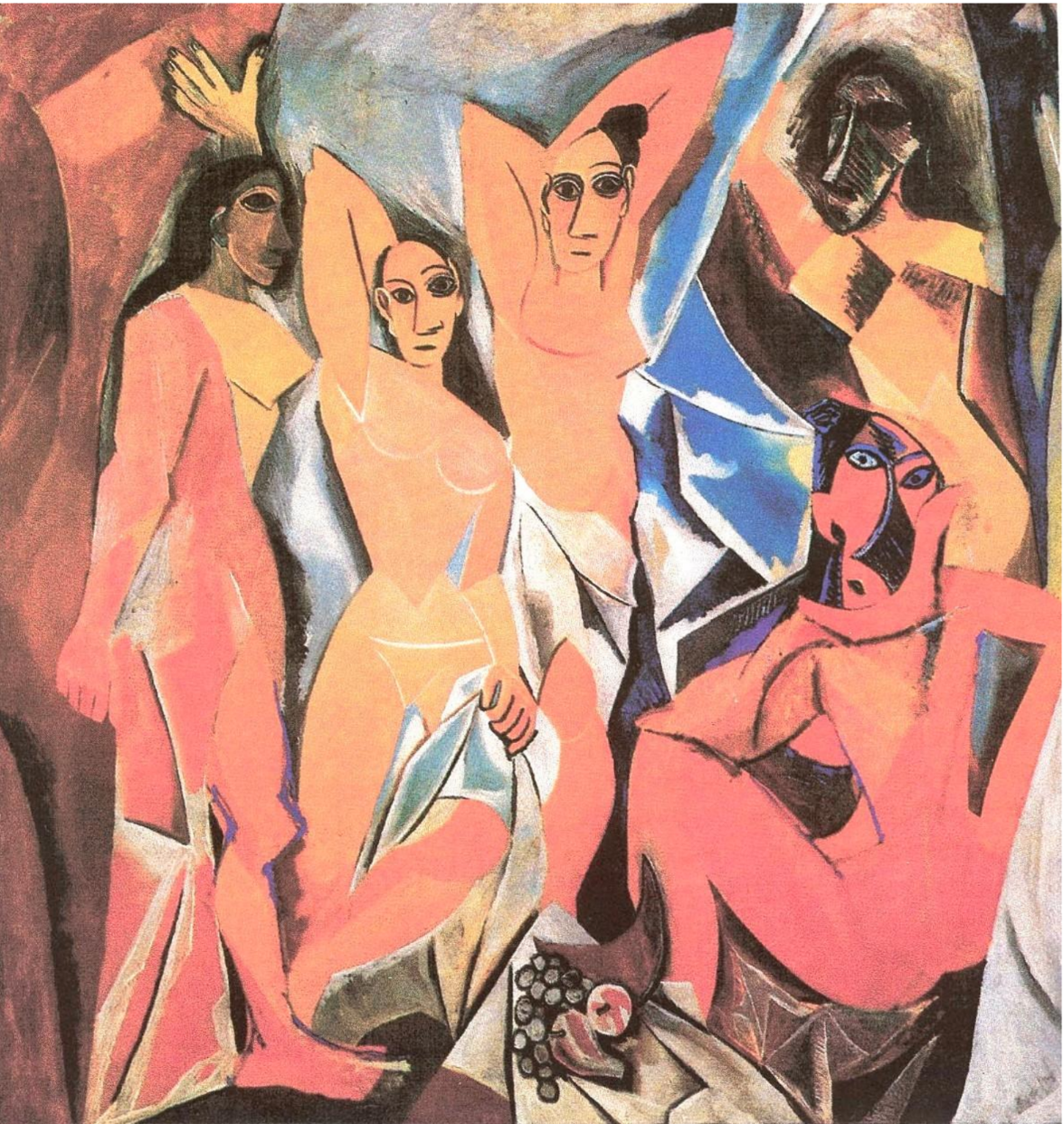
Les Demoiselles d’Avingnon
Pablo Picasso
1907
An example of Picasso’s incorporation of African and Iberian art influences, demonstrating the non-Western roots of abstract art. Also reflects the impact of colonialism on artistic exchange and the cross-cultural influences that reshaped modern art.
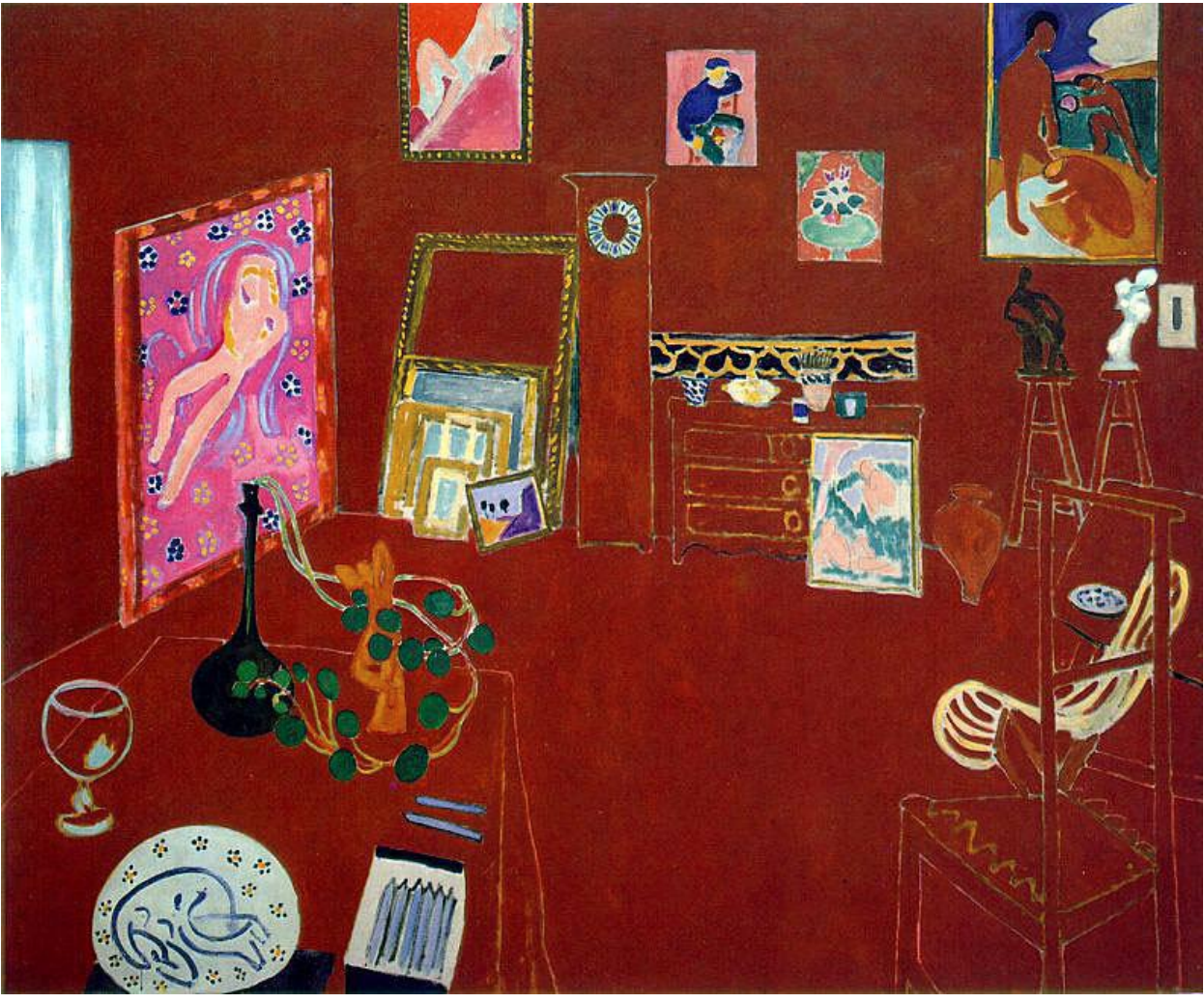
The Red Studio
Henri Matisse
1911
Signifies a departure from traditional artistic representations while also reflecting the artist's engagement with non-Western art forms, underscoring the influence of colonialism in broadening the horizons of Western artists.

Suprematist Composition: Red Square: Peasant Woman
Kasimir Malevich
1915
Oil on canvas
Significance:
Prompts viewers to reflect on how the artist, through his presentation, shapes perception, as Malevich imparts significance to otherwise "meaningless" abstract elements by positioning them in the conventional space reserved for religious icons.

Composition with red, blue, black, yellow, and gray
Piet Mondrian
1921
Oil on canvas
Significance:
Mirrors the philosophy that reality can be simplified to a universal truth of horizontal and vertical elements, revealing an underlying abstract reality beyond representational aspects.
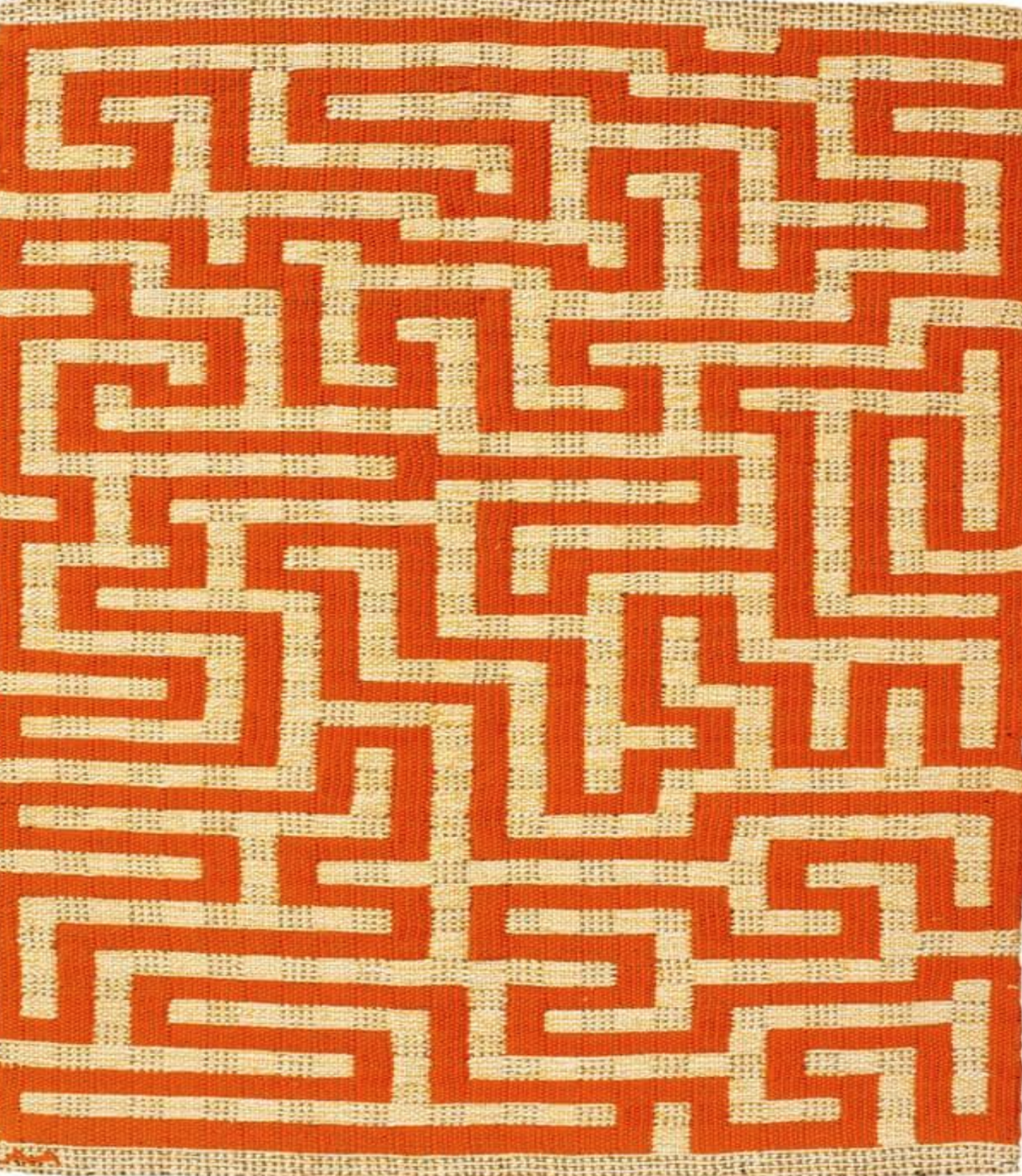
Red Meander
Annie Albers
1954
Aubusson weave with hand knotted pile, handspun wool
Significance:
Significant in challenging the distinction between "primitive" craft and “modern” abstract art, highlighting the cultural biases that have historically marginalized non-Western and female artisans.
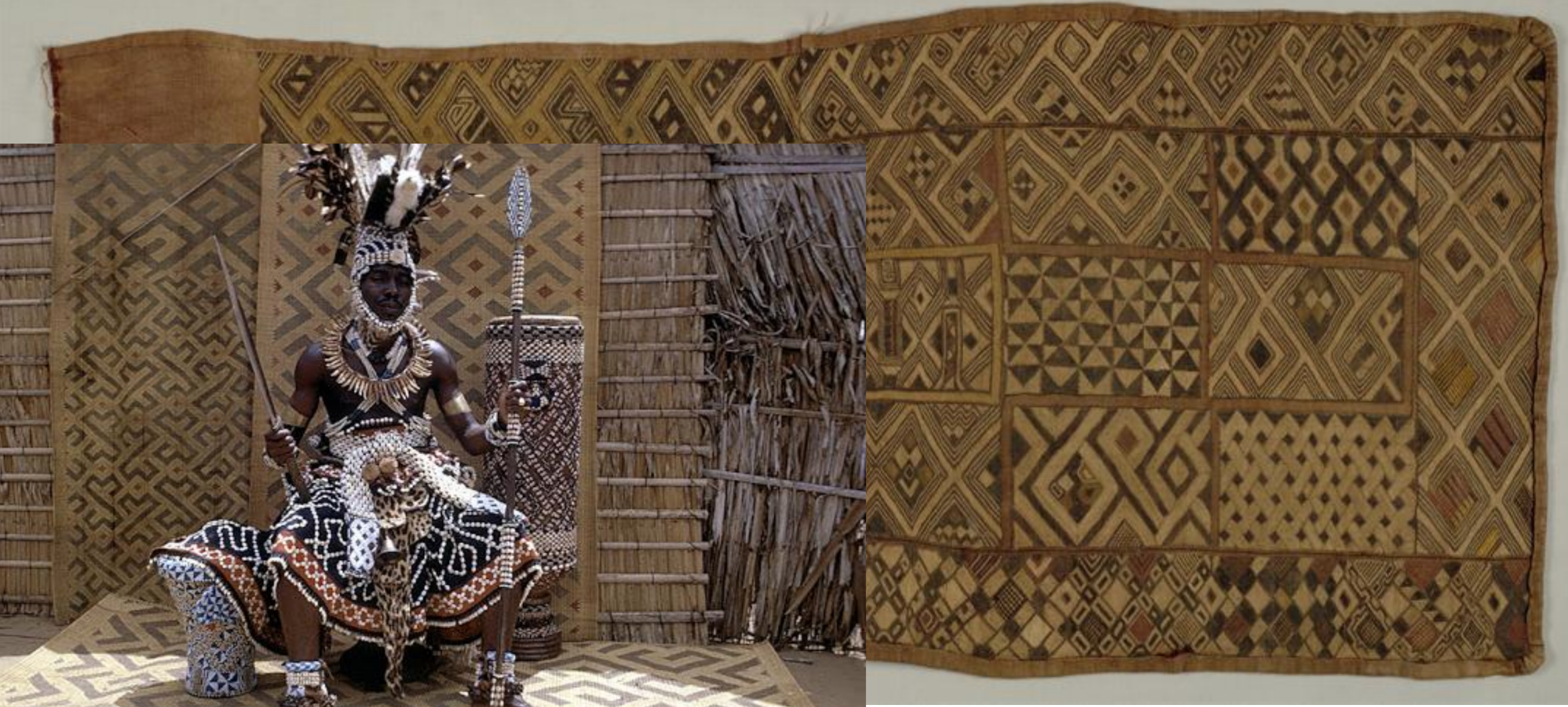
Kuba cloth, raffia, Democratic Republic of the Congo, early 20th c.
1980s
Kuba King (nyim) Kok Mabiintsh III in his artistic and ritual traditional regalia
Significance:
Challenges the historical definition of "primitive" work as mere craft, questioning the underlying racism that has undervalued and mischaracterized non-Western art in the development of abstract art.
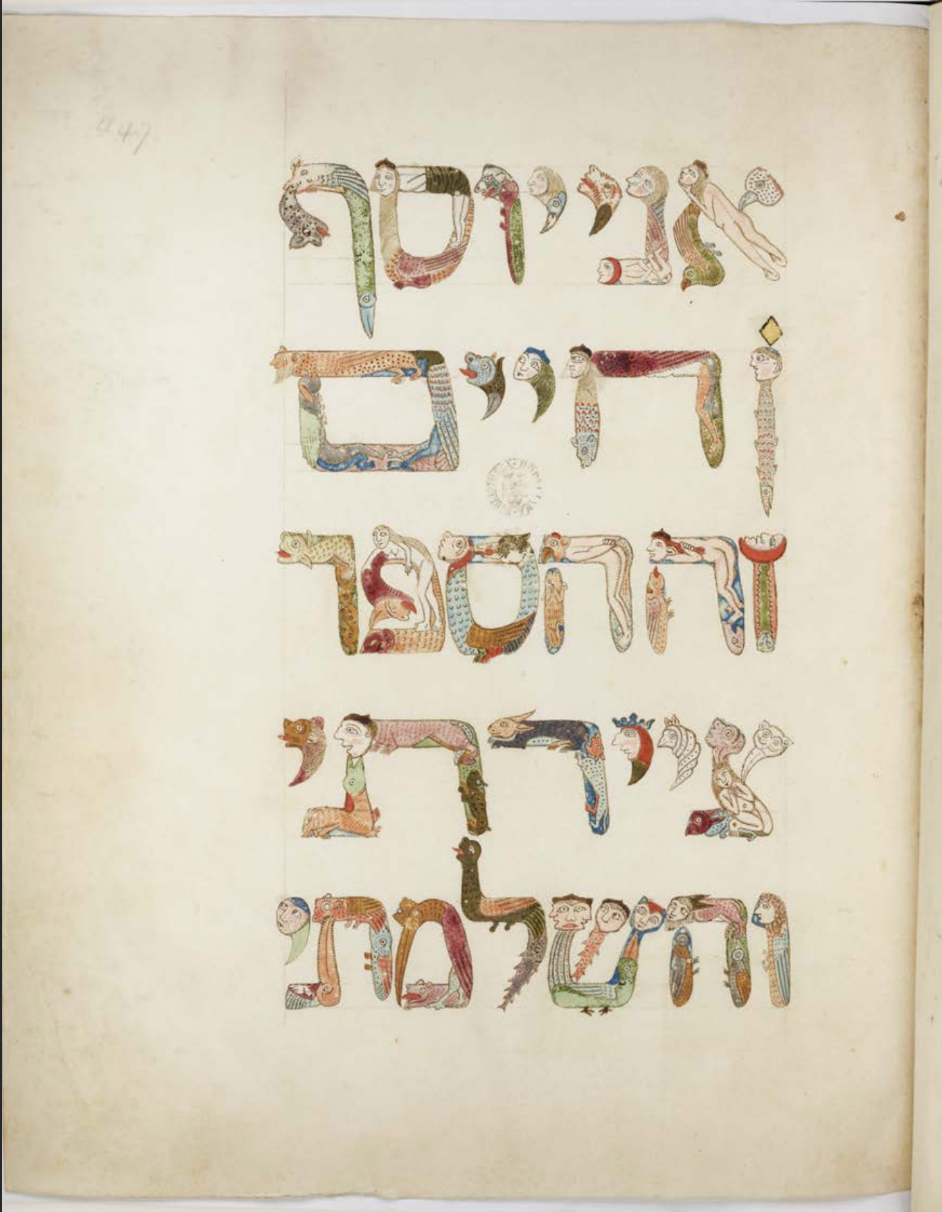
Colophon to the Kennicott Bible
Joseph ibn Hayyim
1476
“I, Joseph ibn Hayyim, have illuminated and completed this book”
Significance:
Showcases the meticulous artistry of manuscript illumination in Jewish culture during the Middle Ages and its influence on abstract design elements in religious manuscripts.
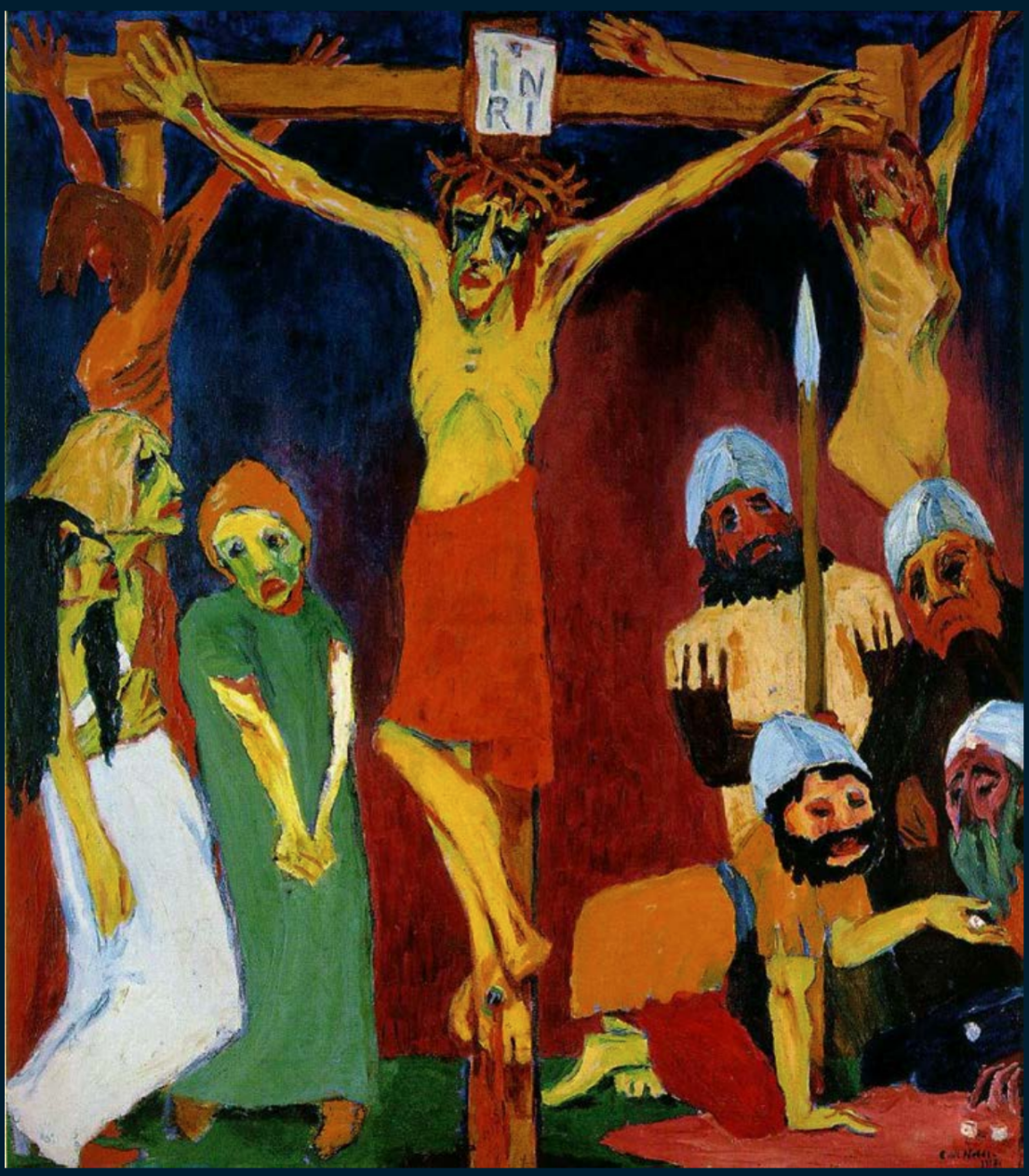
Crucifixion
Emile Nolde
1912
Oil on Canvas
Significance:
Reflects the paradoxical situation of artists like Nolde, who, despite their affiliation with the Nazi party, faced the censorship and suppression of modernist art deemed "degenerate" by the Nazi regime.
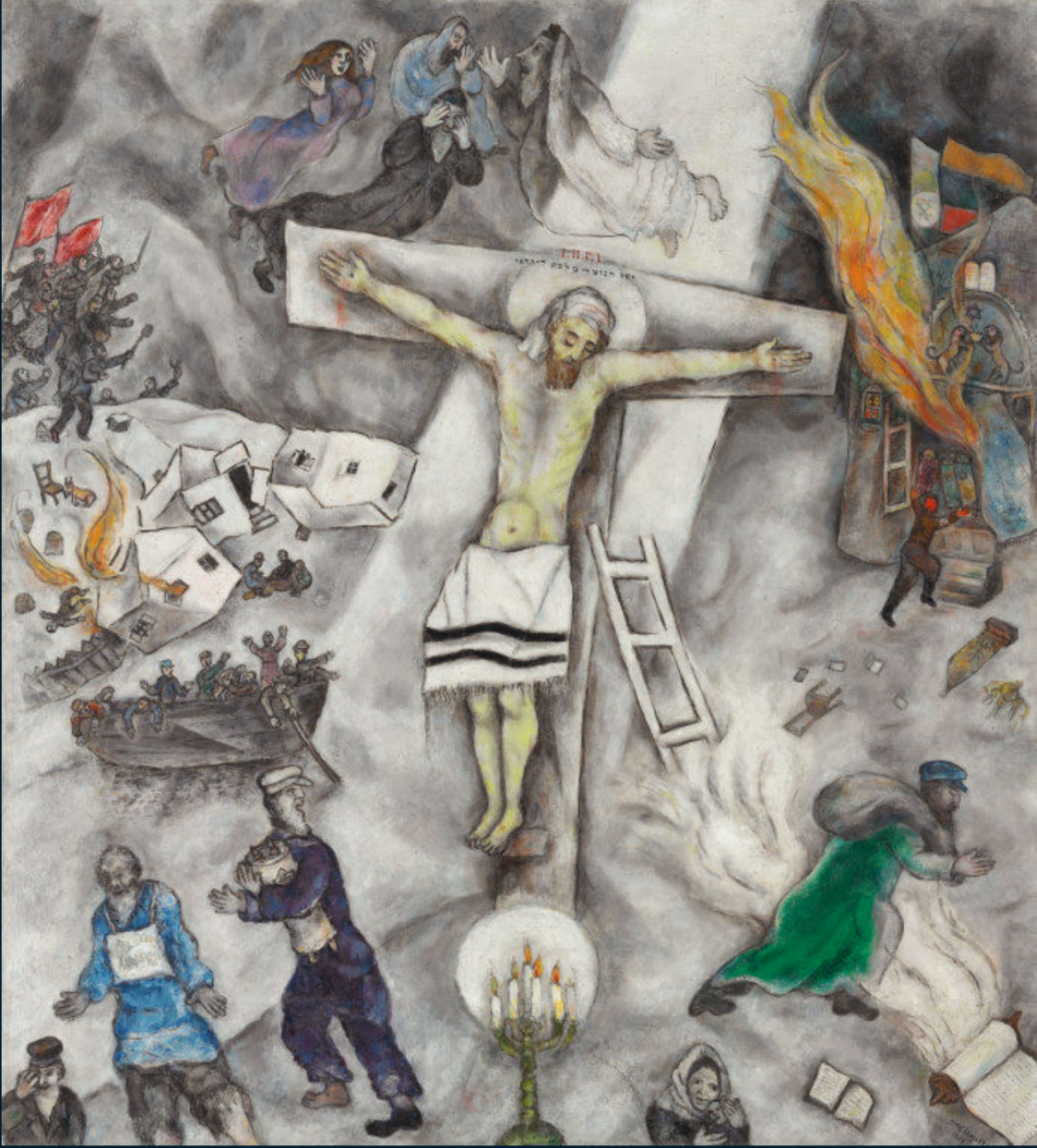
White Crucifixion
Marc Chagall
1938
Significance:
A powerful visual commentary on the persecution of Jews in Europe before and during World War II, blending Christian and Jewish symbolism to convey the collective suffering and hope for redemption amidst the horrors of the Holocaust.

Composition
Lee Krasner
1949
Significance:
Reflects Krasner’s unconscious connection to Hebrew writing and her deliberate creation of an abstract language that defies interpretation, offering a unique perspective on the intersection of her Jewish heritage and abstract expressionism.
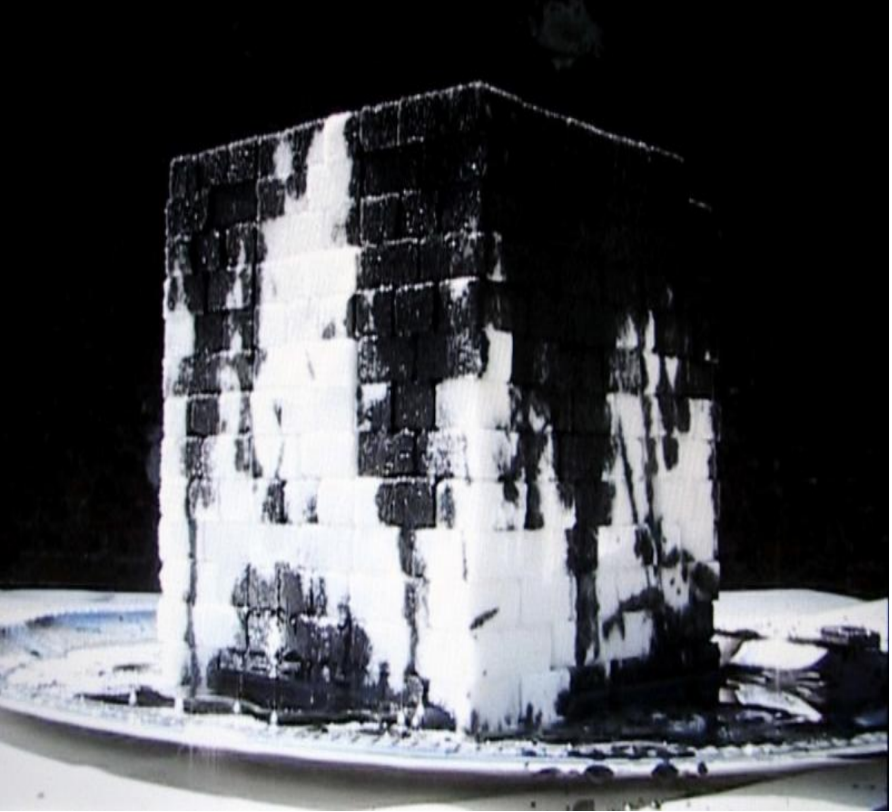
Oil and Sugar
Kader Attia
2007
Video
Significance:
Explores themes of globalization, economic inequality, and cultural exchange by juxtaposing the production of oil and sugar through an abstract lens.
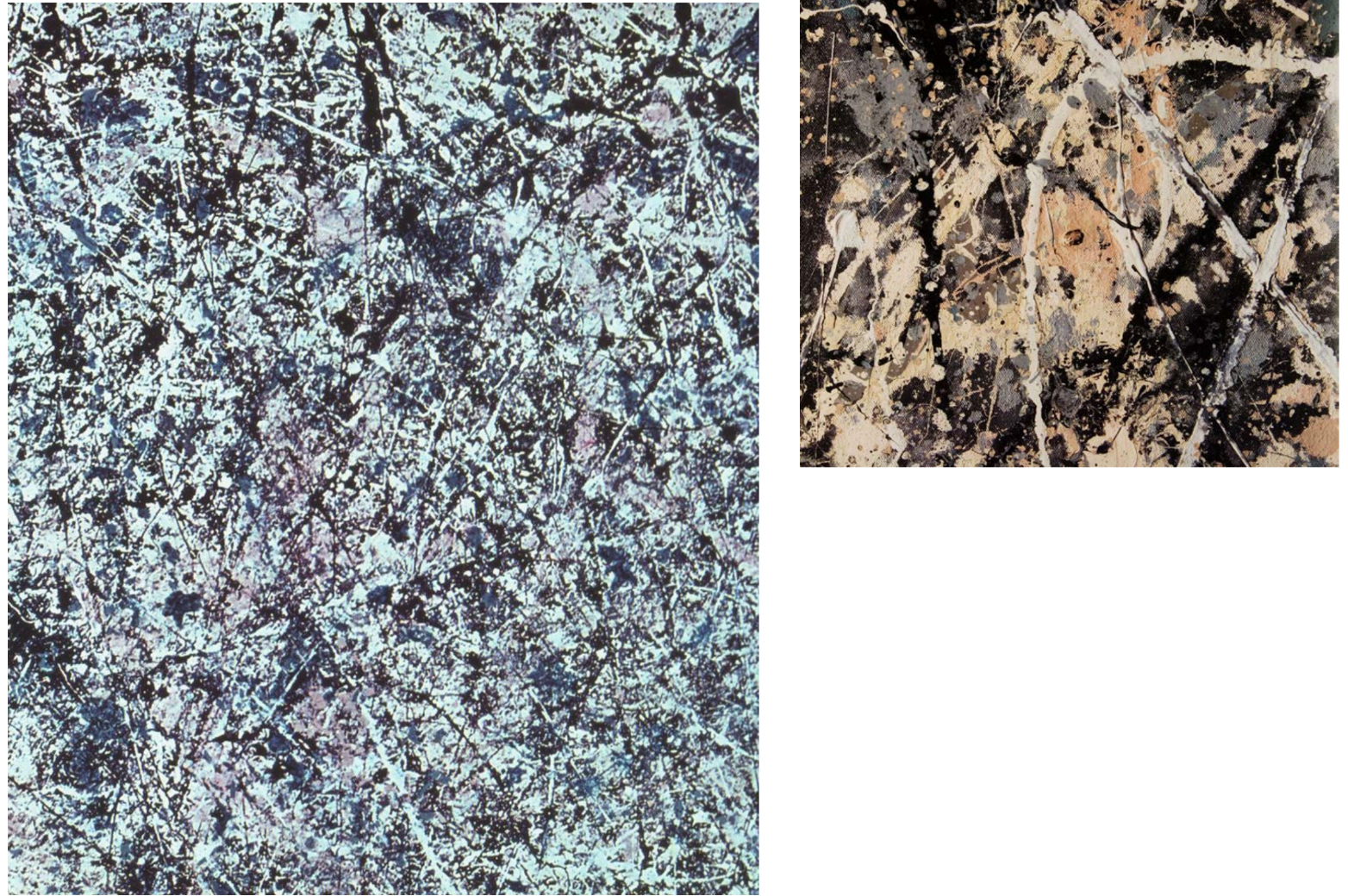
Number 1, Lavender Mist
Jackson Pollock
1950
Oil on canvas, & detail
Significance:
Significant as a seminal work of abstract expressionism, exemplifying Pollock's revolutionary "drip painting" technique that pushed the boundaries of artistic innovation.

Photograph of Jackson Pollock at work, East Hampton, NY
Hans Namuth
1950
Significance:
Provides a glimpse into Pollock’s unconventional "drip painting" technique, fueling debates and discussions about the nature of abstract art, relationships between artist and material, and the role of intentionality and control in art.

Factum I and Factum II
Robert Rauschenberg
1957
Oil on canvas
Significance:
Significant in relation to Rauschenberg's critique of the singularity of abstract art, challenging the proclaimed spontaneous and uncontrolled nature of abstract expressionism with a deliberate act of recreation.

Race Riot
Andy Warhol
1964
Significance:
A powerful commentary on racial violence, using Warhol's signature silkscreen technique to depict a pivotal moment in civil rights history, thereby challenging the conventions of celebrity-focused pop art by addressing urgent social issues.

Abaporu
Tarsila do Amaral Talk Don’t Ask
1928
Oil on canvas
Significance:
Merges indigenous influences with modernist aesthetics to celebrate Brazil’s cultural diversity, using the metaphor of cannibalism (anthropophagy) to symbolize the forceful assimilation of external influences.
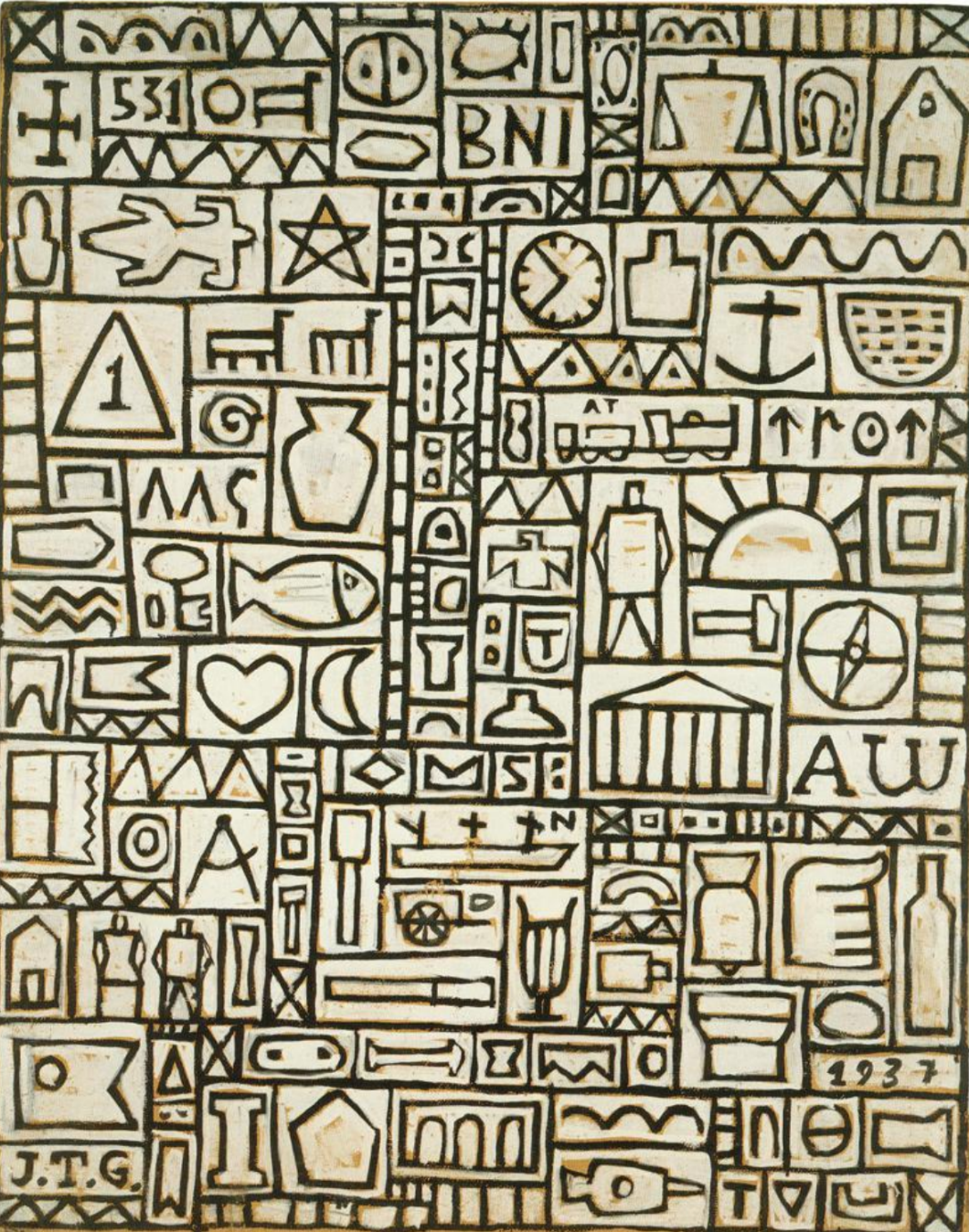
Universal Composition
Joaquín Torres-García Jump The Gun
1937
Merges abstraction with figuration to translate indigenous pre-colonial history into modernity, with a distinct focus on the grid to symbolize life as interconnected building blocks within the Constructive Universalist movement.
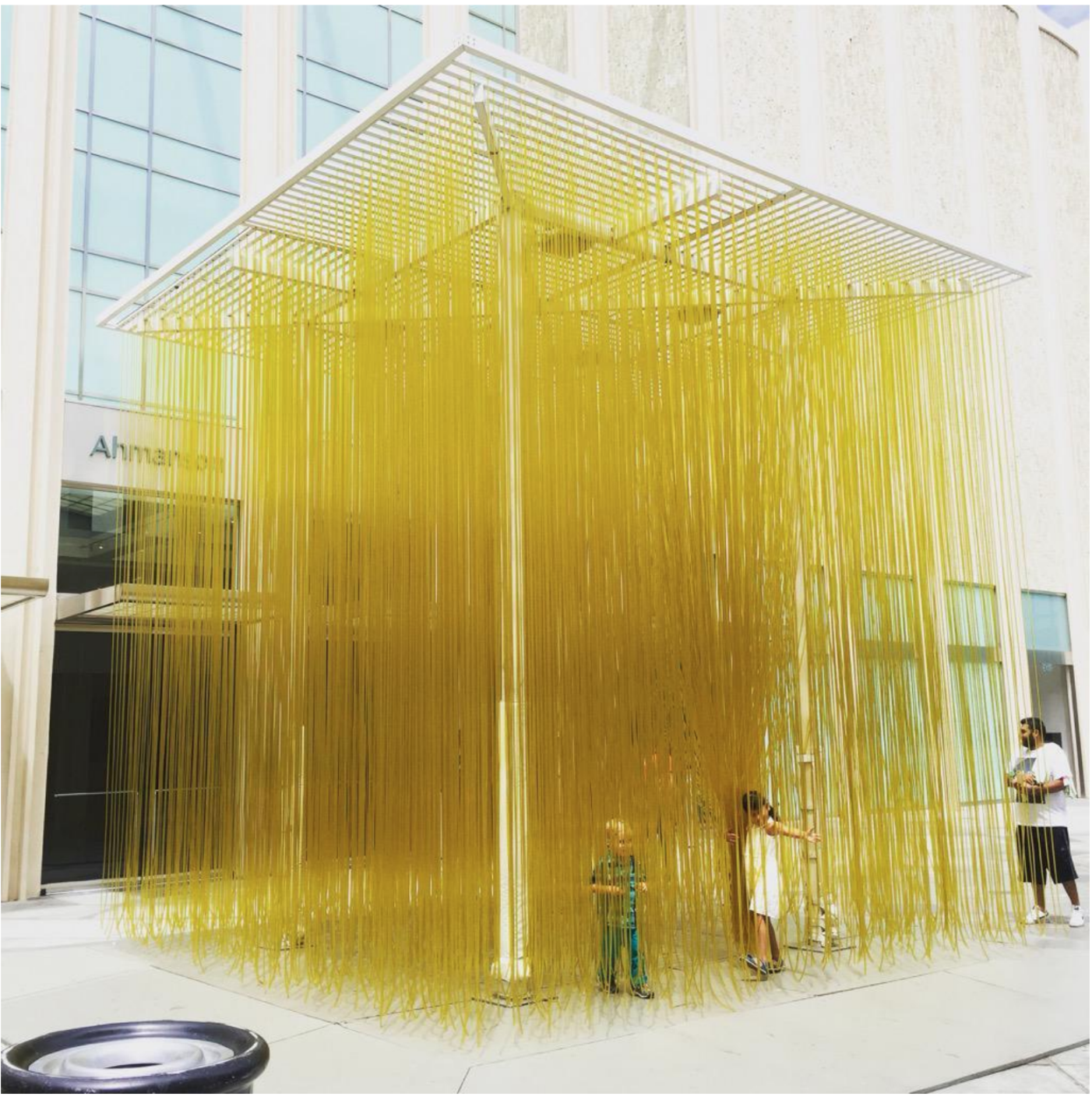
Penetrable
Jesús Soto
1990
Creates a tangible abstraction that serves as an invitation for viewer interaction, where the viewer's body becomes a part of the movement, and the subject dematerialized into the surrounding space.
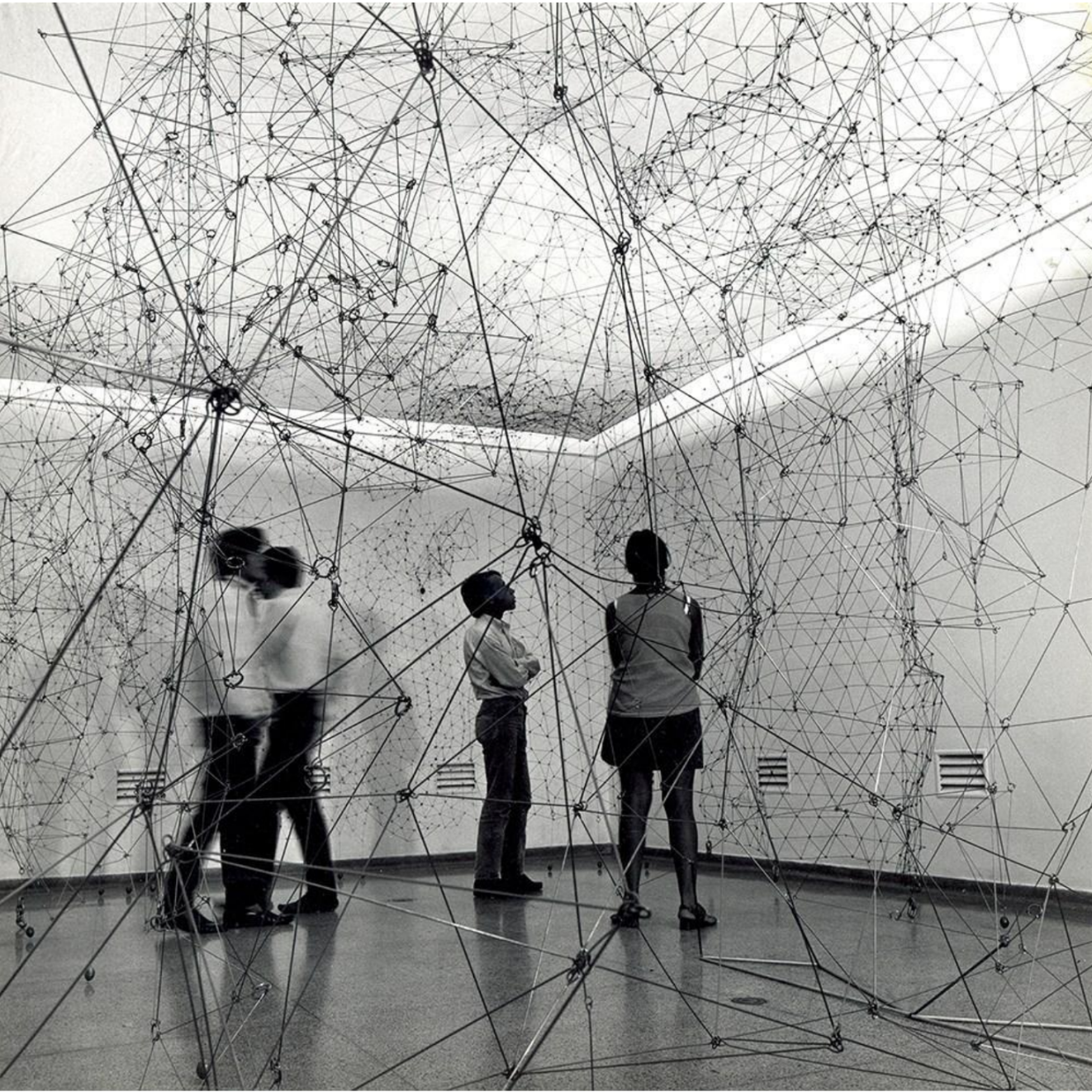
Gran reticulárea
Gertrud “Gego” Goldschmidt
1969
Stainless steel
Significance:
Innovative exploration of spatial relationships, embracing a type of abstraction that eschews clarity or universality, instead embodying a “quasi-corpus” (associated with Neo-Concretism, aimed to break away from strict formalism).
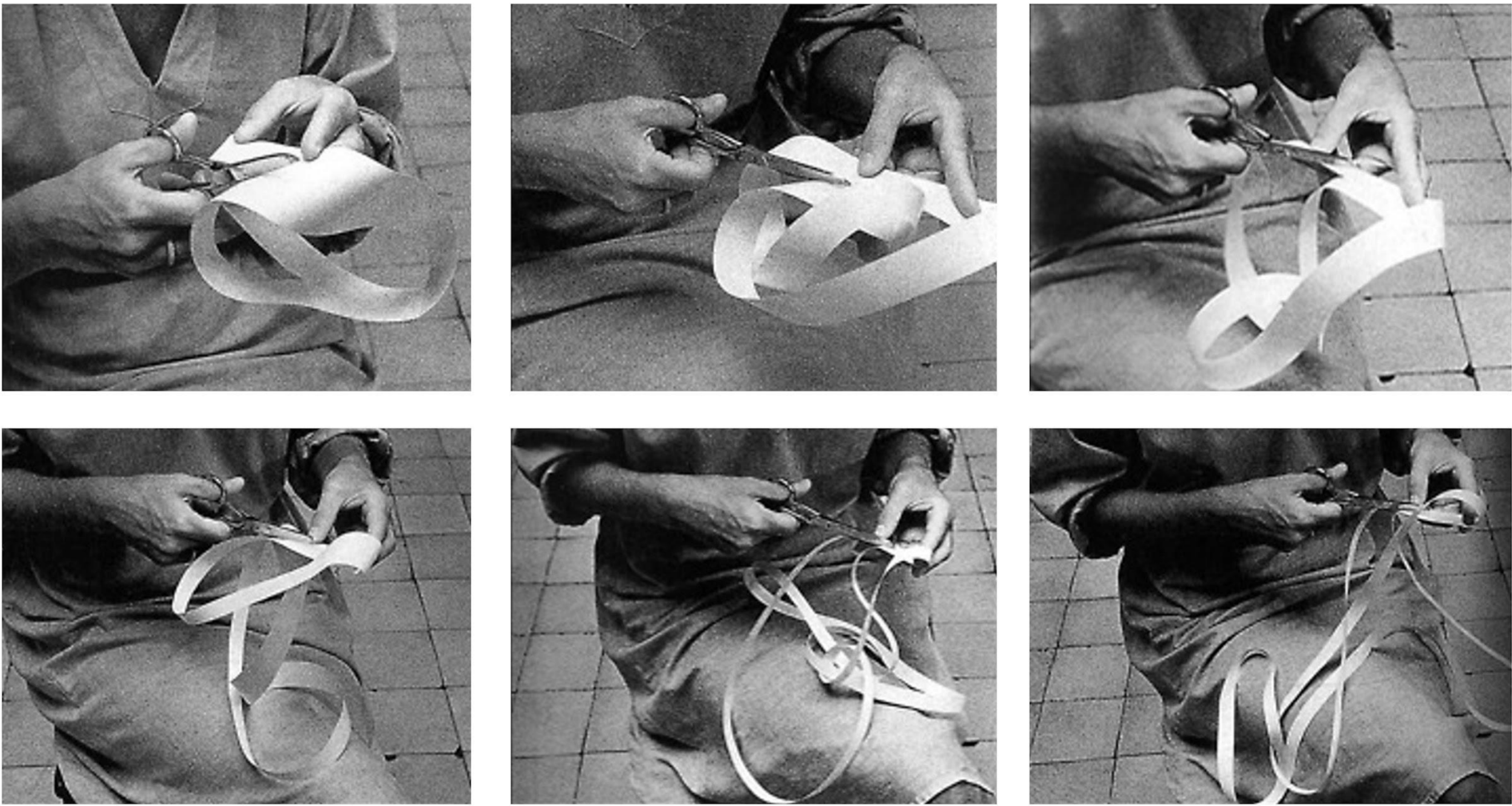
Walking
Lygia Clark
1963
Scissors and paper
Significance:
Invites viewer participation and sensorial engagement, as it explores the intersection of art and the human body, fostering a more experiential relationship with the artwork

Die Fahne Hoch Die Fearing Hell
Frank Stella
1959
Oil on canvas
Whitney Museum, NYC
Significance:
Significant for its pioneering role in the development of Minimalism by employing geometric shapes and emphasizing the flatness of the canvas, pushing the concept of anti-expressiveness. An example of glorified male artists making big claims for their work
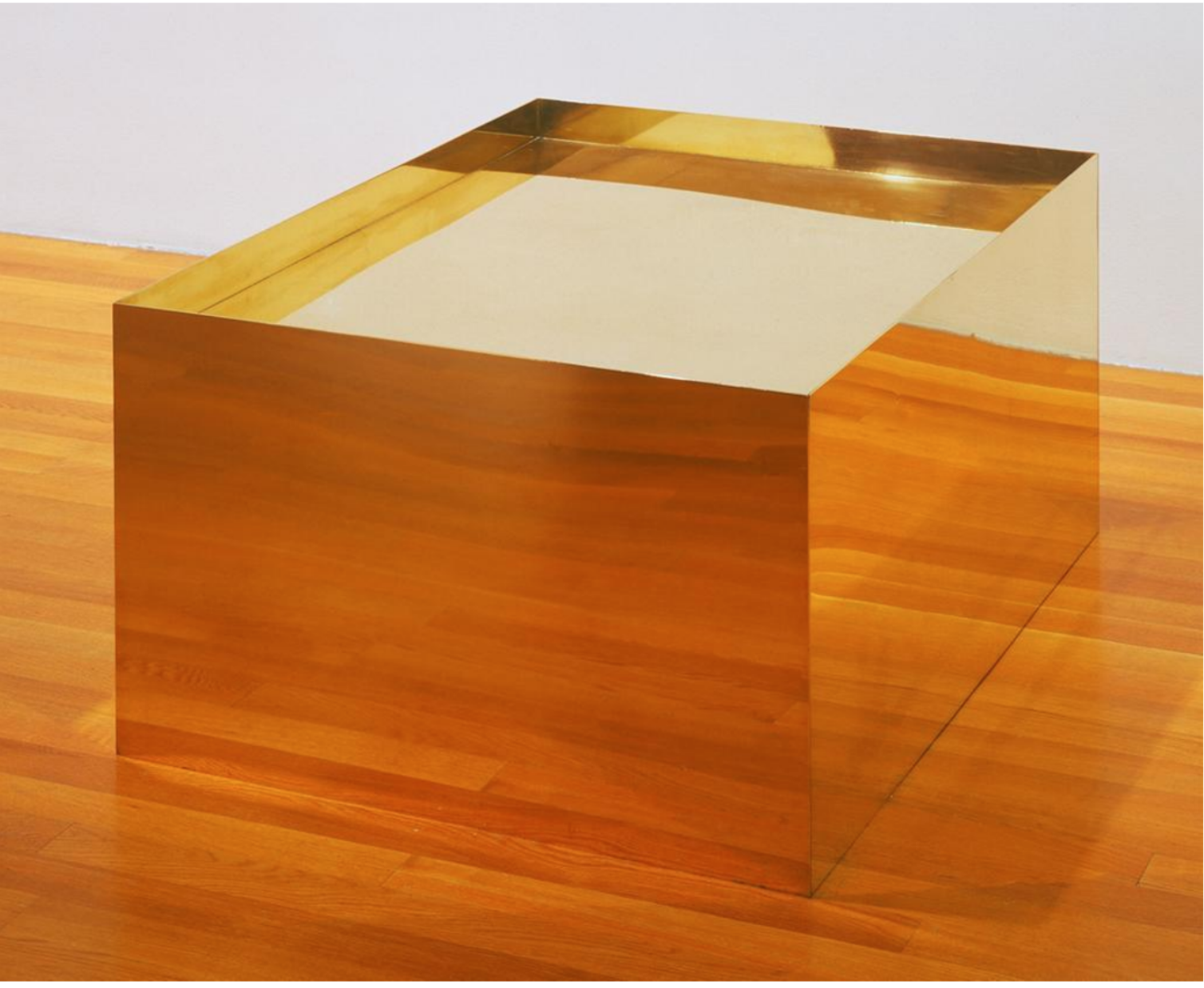
Untitled
Donald Judd
1968
Significance:
Represents the minimalist commitment to geometric simplicity, industrial materials, and the elimination of artistic subjectivity.
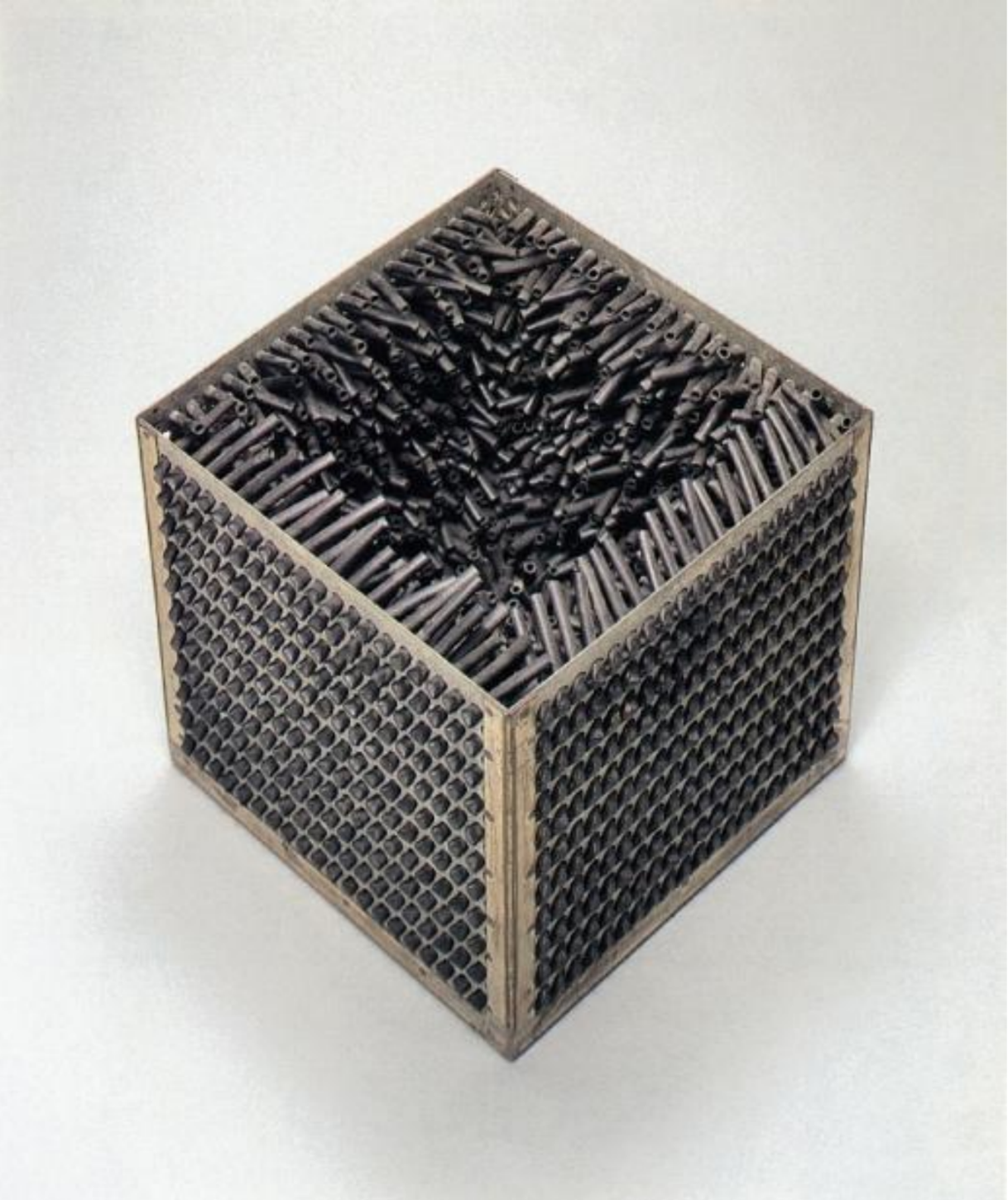
Accession iv
Eva Hesse
1968
Enamel paint and string over paper-mâché with elastic cord
33½ x 26 x 2½
Significance:
A pioneering contribution to post-minimalism, Hesse used unconventional materials that invites a tactile engagement and emphasizes the corporeal in her approach to form and texture. A feminist revision of minimalism
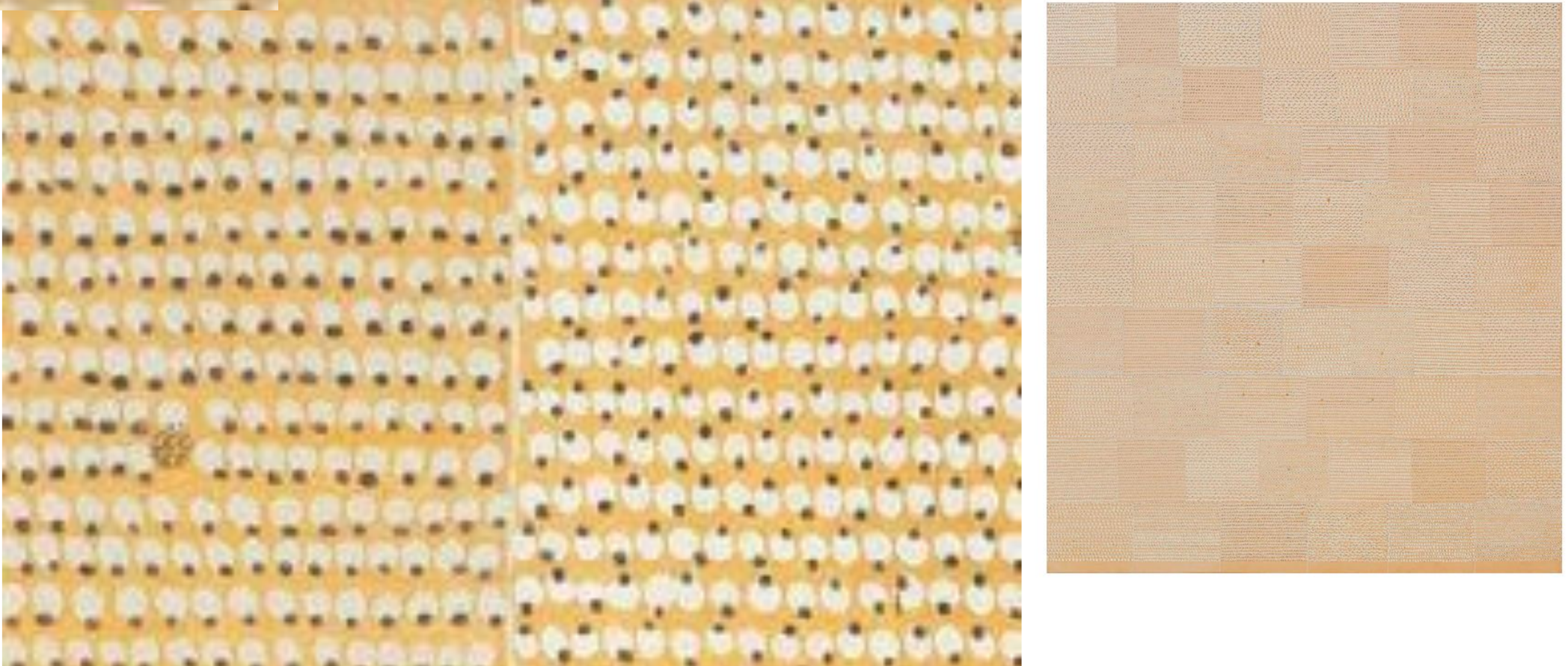
Untitled
Ellen Gallagher
1996
Oil, pencil, paper and incisions on canvas, & detail
Significance:
Exploration of identity, race, and cultural memory, prompting a post-minimalist reconsideration of the impact of slavery and the representation of Black experiences.

What you see is what you see
Hank Willis Thomas
2016
Significance:
Engages with the complexities of perception, representation, and racial identity, challenging viewers to confront their own preconceptions and the impact of visual language on social constructs
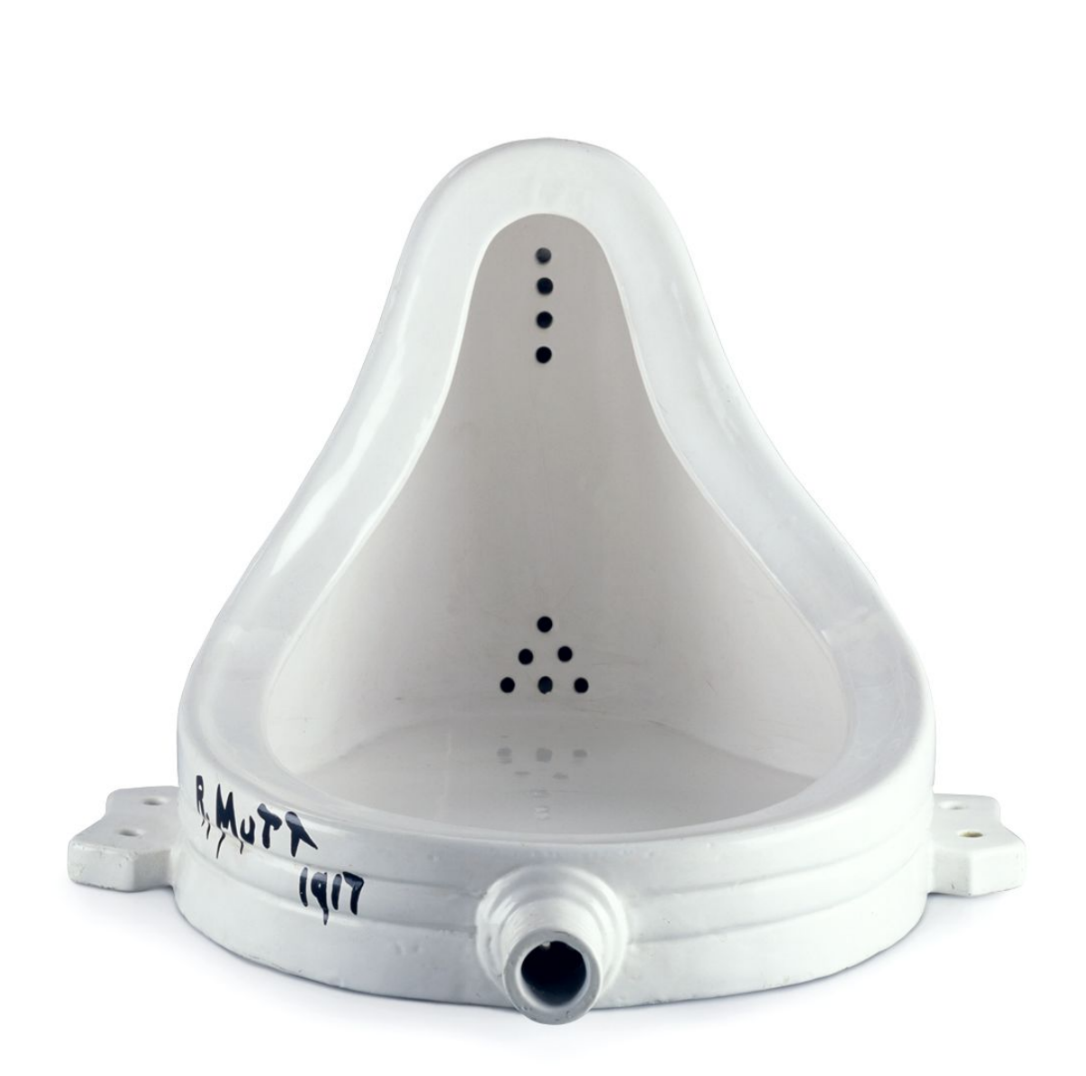
Fountain
Marcel Duchamp
1917
Readymade
Significance:
Exemplifies the Dadaist concept of "deskilling" by letting the audience decide what becomes art, thereby questioning traditional artistic craftsmanship and the role of the artist in the creation of art.

One and Three Chairs
Joseph Kosuth
1965
Wood folding chair, mounted photograph of
chair, mounted photographic enlargement of the
dictionary definition of “chair”
Significance:
A seminal work in Conceptual Art, challenging traditional notions of artistic production by highlighting the interplay between language, perception, and the conceptual nature of art.
Conceptualism: art is the action of thinking
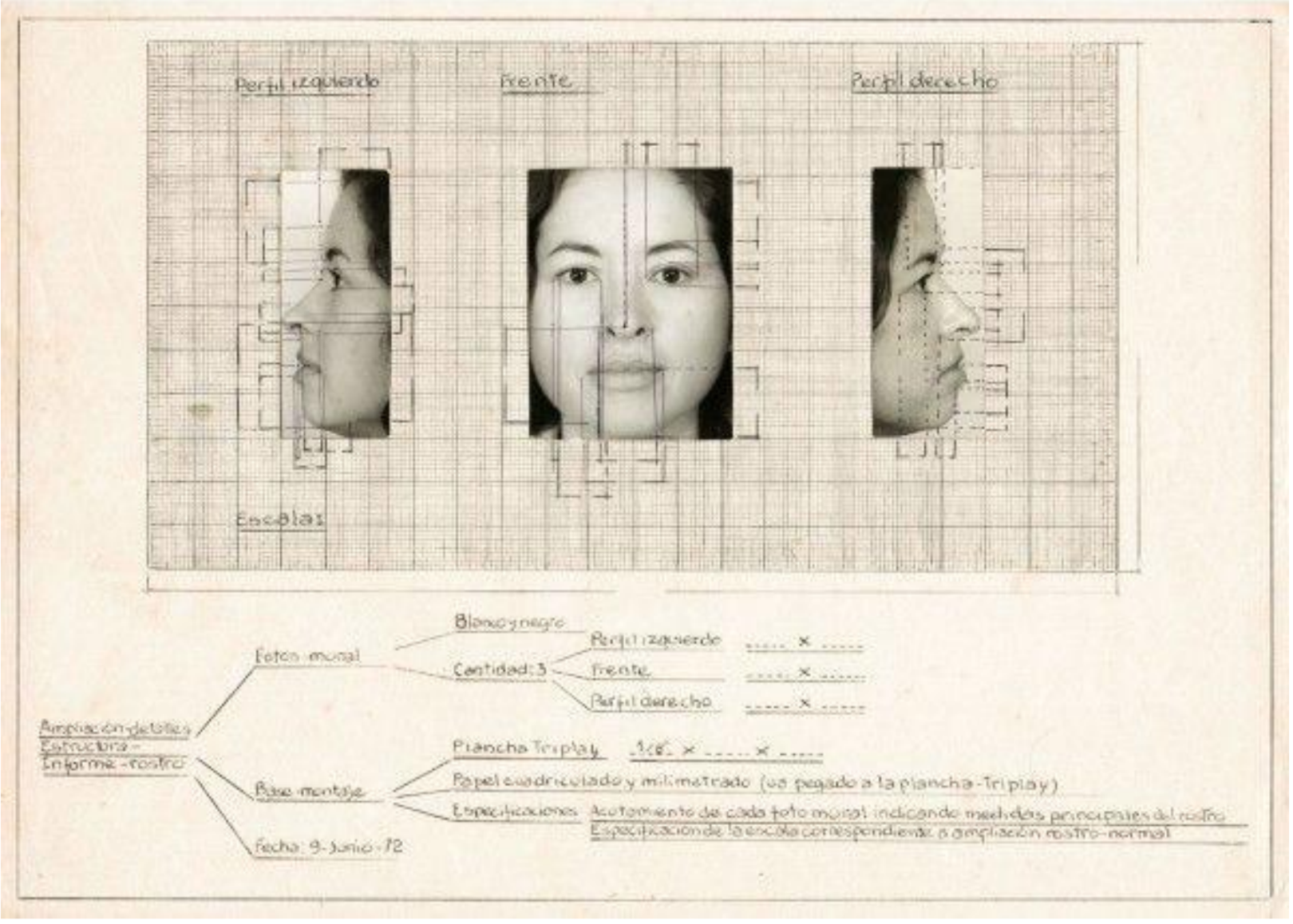
Self-Portrait. Structure. Report, 9/6/1972
Teresa Burga
1972
Installation of identity documents,
phonocardiogram, electrocardiogram,
blood analysis results, and diagrammatic analysis
Significance:
Significant for its contribution to conceptual and feminist art, exploring the intersection of identity, societal structures, and the role of women in art during the 1970s.
Additional notes:
As Burga herself is subjected to different visual forms of intense analysis, she as a person is broken down
Decomposing a person into images, symbols, and numbers
Dissecting the identity of a woman under a bureaucracy

Insertions into Ideological Circuits:
Coca-Cola Project
Cildo Meireles
1970
Screenprint on Coca-Cola bottles
Significance:
A significant artwork that engages with Conceptual Art and activism, challenging consumerism and highlighting the potential for art to disrupt established ideological circuits.
Additional notes:
Returns modified products to circulation
Uses an object of mass production, a symbol of capitalism and U.S imperialism to spread information and political critique under a time of censorship

No +
CADA
1983–present
Action
Significance:
An ongoing artwork that challenges
authoritarianism and censorship, using a
simple yet effective symbol of a red plus
sign to signify resistance and provide the
public a platform to speak

Sun Tunnels
Nancy Holt
1973-76
Concrete
Great Basin Desert, Utah
Significance:
Consisting of large concrete tunnels aligned with celestial events, this earthwork provides an immersive experience that blurs the boundaries between art and nature while inviting contemplation of the cosmic and earthly rhythms.
Additional notes:
Earthworks: art that in some way engages with the earth in a direct, material way
Site-specific work
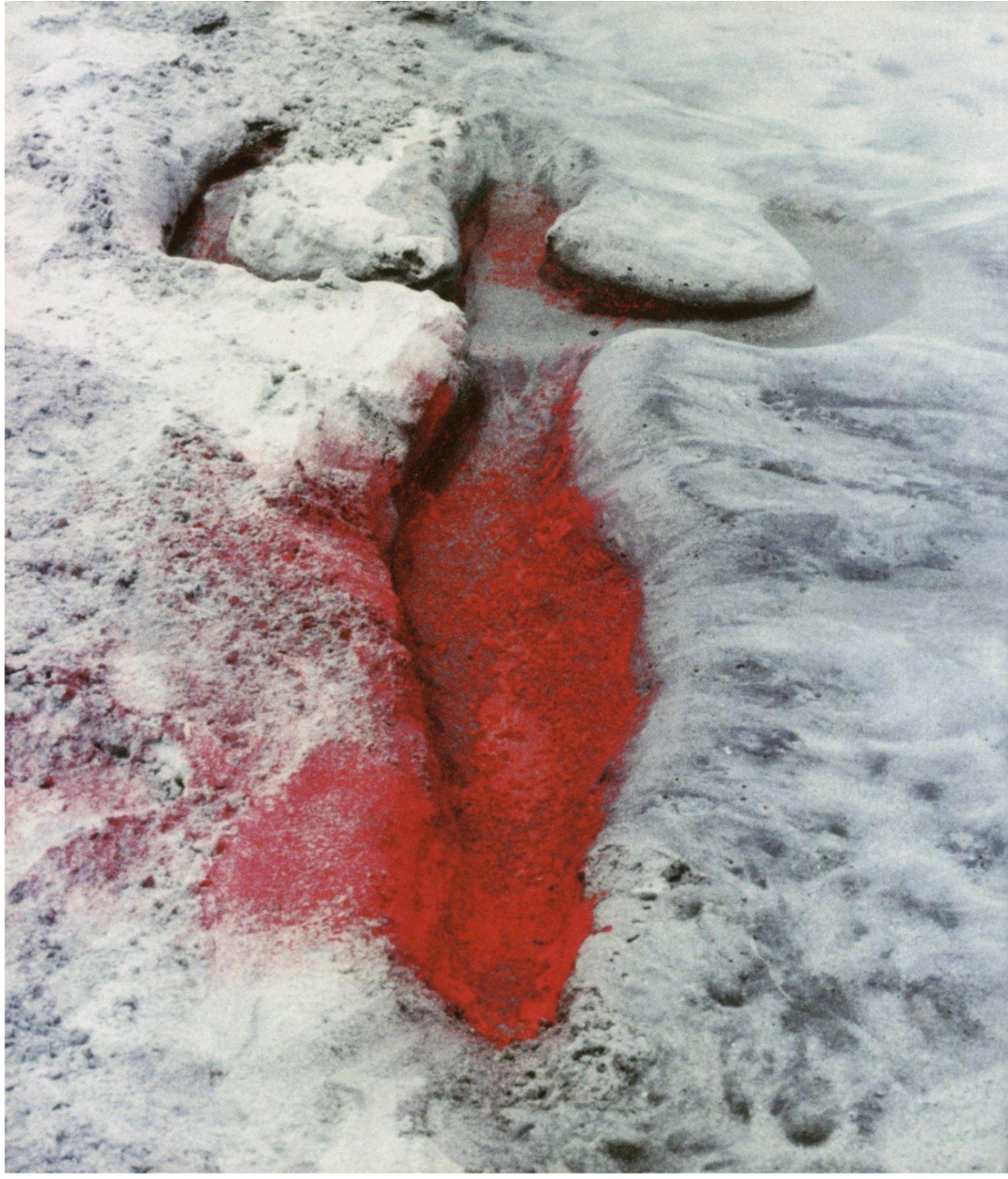
Silhouette series
Ana Mendieta
1973-78
Earth-body works
Significance:
Explores themes of identity, connection to nature, and the female body, employing the artist's own silhouette without objectifying it to create evocative earthworks.

Guardian
Cecilia Vicuña
1967
Mixed media, found objects
Significance:
An embodiment of Vicuña’s commitment to engaging with indigenous traditions and challenging established Western artistic norms, offering a critical perspective on settler colonialism through the use of unconventional materials and forms.

Wheatfield - A Confrontation
Agnes Denes
1982
Two acres of wheat
New York City
Significance:
An example of land art, provoking contemplation on the intersection of nature, urban development, and human impact, highlighting ecological concerns through a powerful artistic intervention.
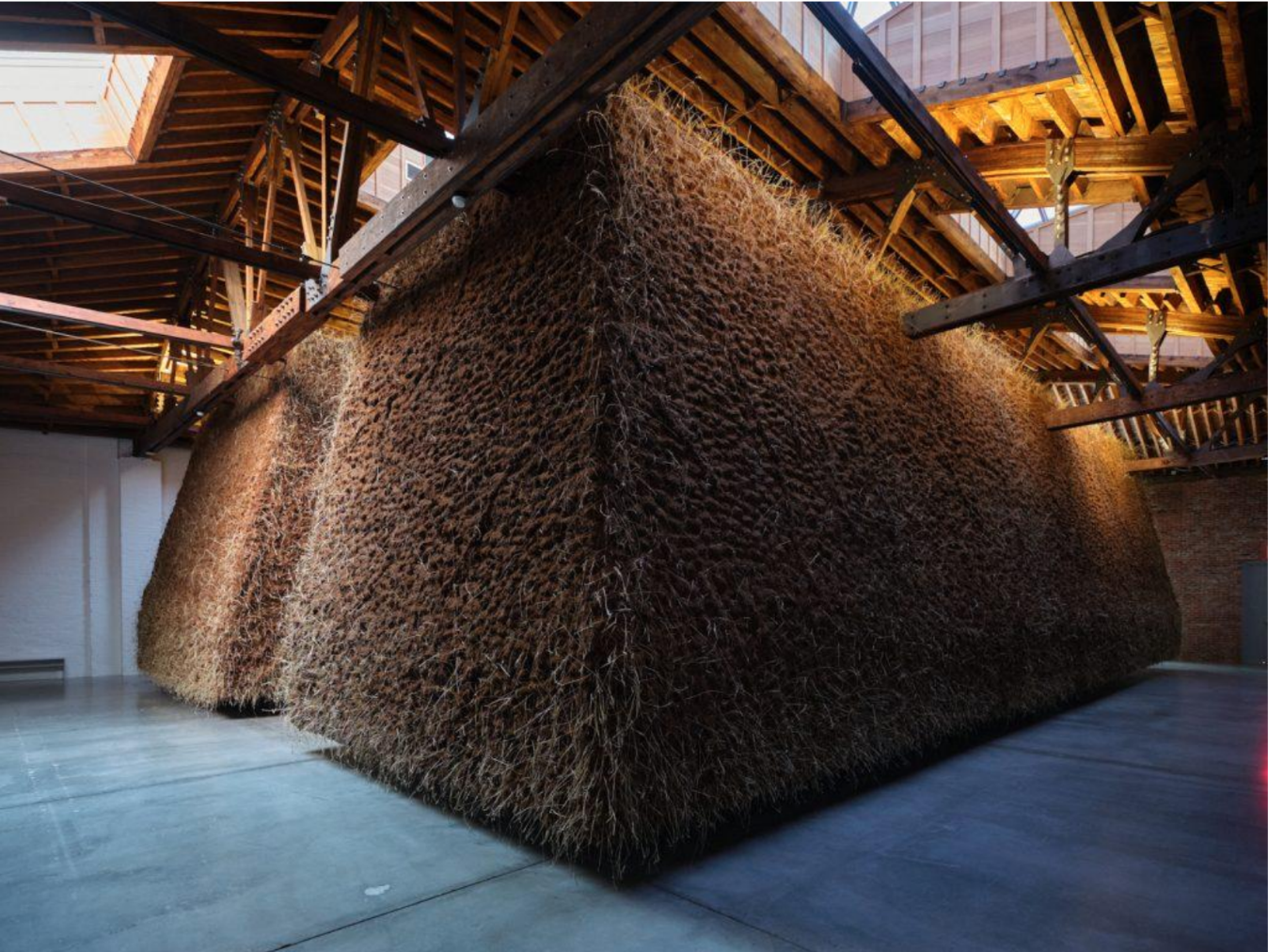
El abrazo (The Embrace)
Delcy Morelos
2023
Recycled garden soil, clay from Dia Beacon, coir,
hay, cinnamon, clove, copaiba oil, Eco Tackifier,
water, and fragrance
Instructions to Touch the Earth
Let the hands listen, see the smell of the earth
with the fingertips, let its taste be savored by
the skin.
Let the hand rise and fall, gently caressing the
surface.
Earth is as fragile as we are.
If you hurt her, you hurt me, you hurt yourself.
To touch the earth is to be touched by her.
Significance:
Explores themes of connection, unity, and cultural identity, conveying a message about shared humanity while prompting reflection on the impact of settler colonialism on indigenous communities.
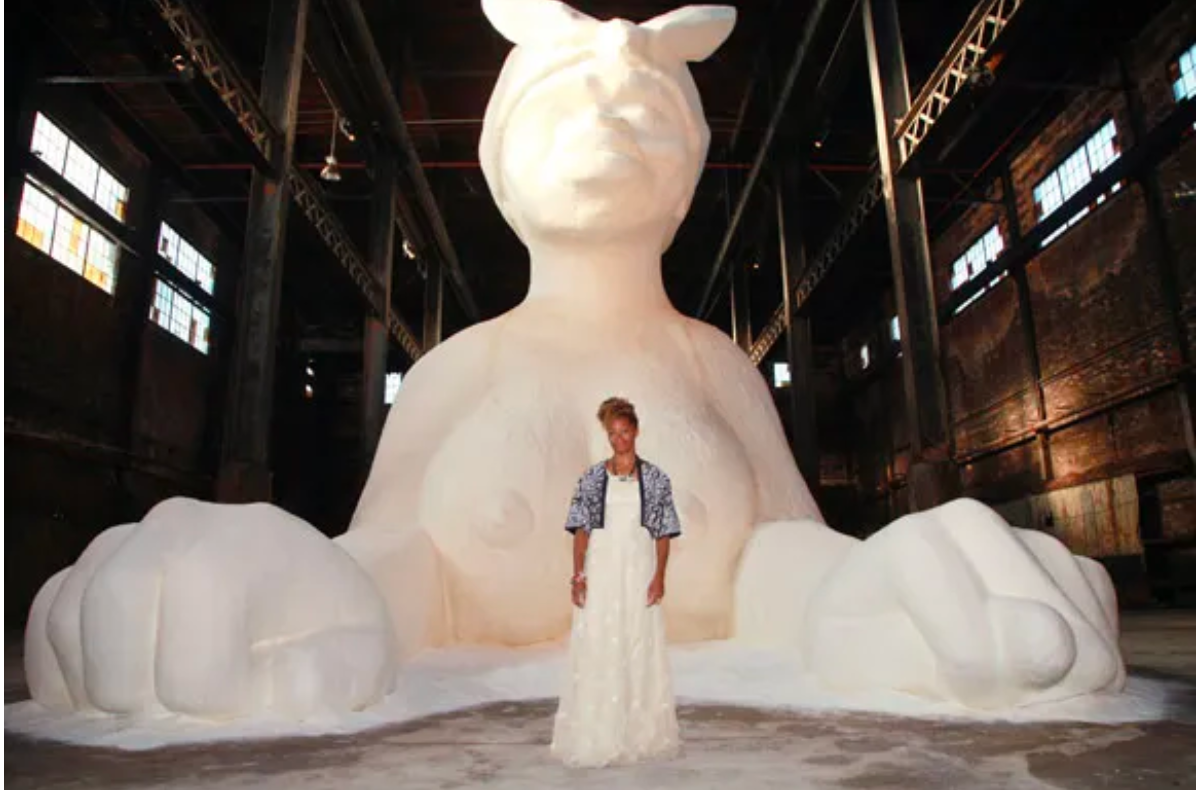
A Subtlety
Kara Walker
2014
Sugar, polystyrene, plastic, and molasses
Domino Sugar Factory
Significance:
Confronts the legacy of slavery and the exploitation of Black bodies, challenging viewers to engage with complex issues of race, history, and power while engaging with material as an end, rather than a means to an end.
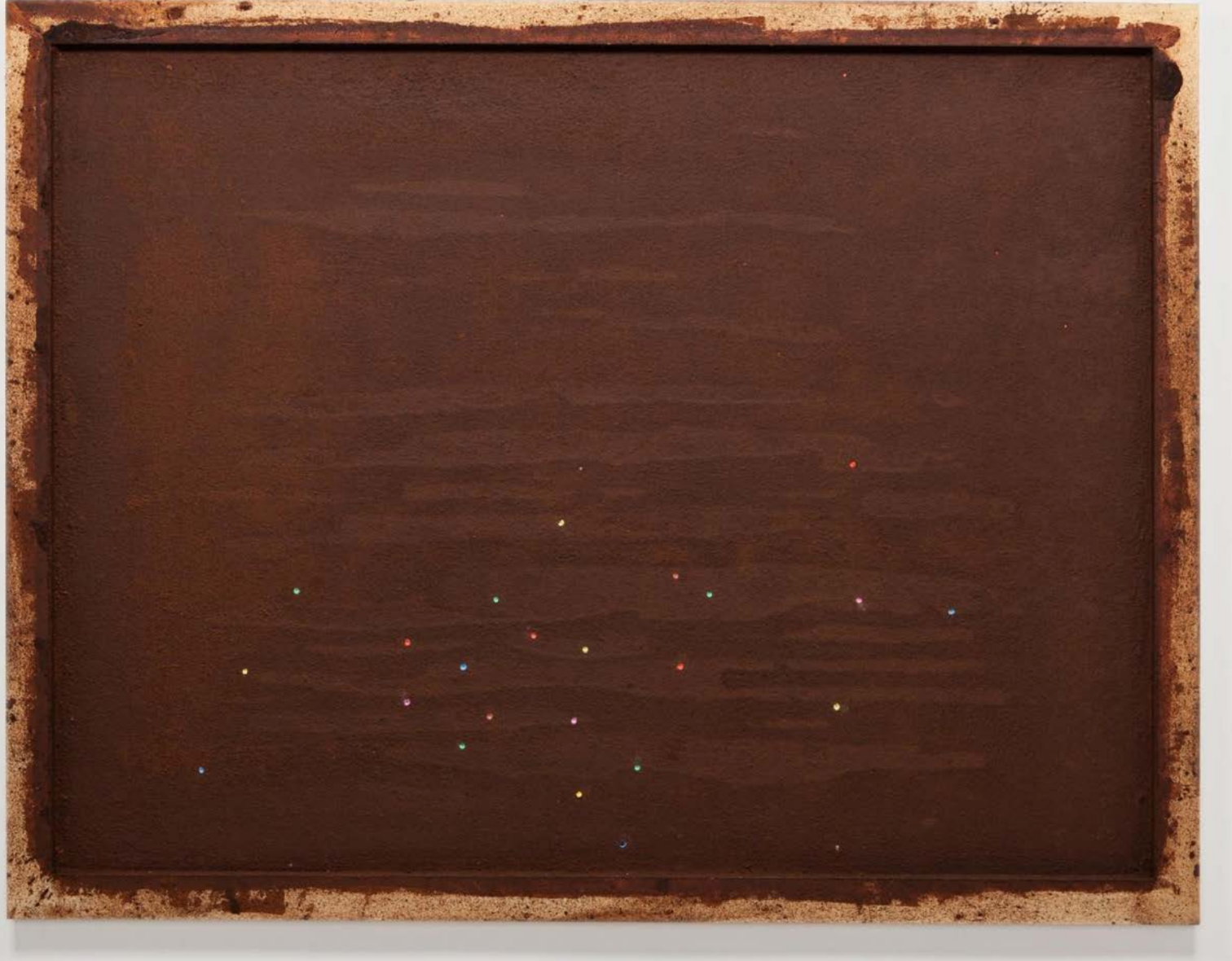
Sierra Leone Landscape
Pascale Marthine Tayou
2010
Wood, frame with chocolate and coffee,
paillettes, chalks
164 x 210 x 5 cm
Significance:
Explores themes of post-colonial identity and global interconnectedness, using a deliberate array of materials to critique abstraction and prompt reflection on Western Imperialism.
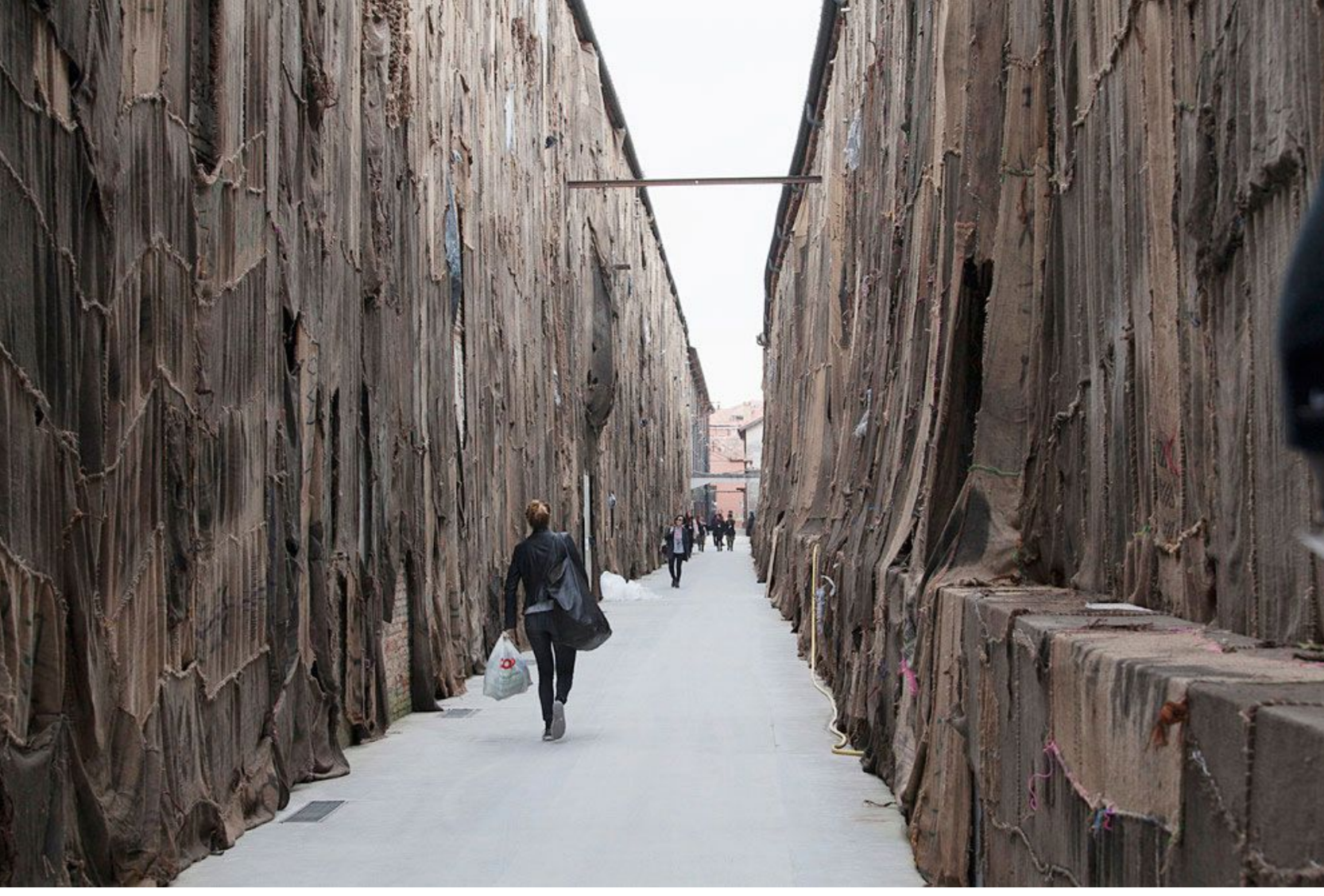
Out of Bounds
Ibrahim Mahama
2014-15
300 meter-long installation of jute sacks on an
outside corridor next to the Arsenale
Commissioned by 56th Venice Biennale
Significance:
Uses jute sacks to address themes of labor, migration, and global economic systems, inviting viewers to contemplate how histories are embedded in everyday materials.
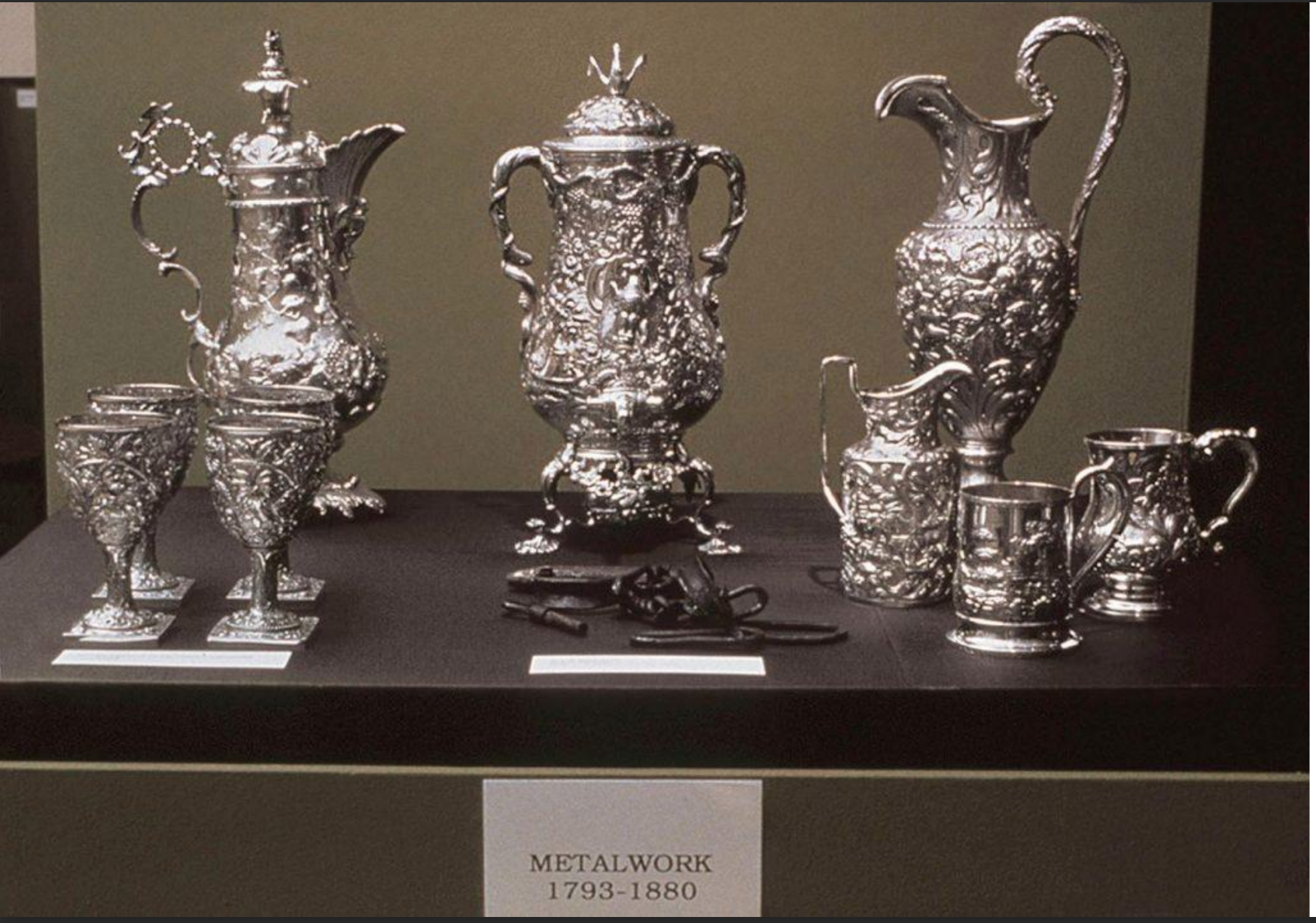
Mining of the Museum
Fred Wilson
1992-93
Maryland Historical Society
“What is the material relationship between silver
jugs and slave shackles?”
Significance:
Reimagines historical artifacts, challenging traditional museum narratives and prompting a critical examination of how museums shape perceptions of race, power, and history.

We Are Still Here
Jacqueline Medez, Marc Nicely, and Larry
Sallaway Joyful Monkeys Make Noise Leaping Swiftly
2009
Exterior of Cesar Chavez Student Center
SF State Ethnic Studies Murals
Significance:
An homage to the Bay Area Native Americans who have endured oppression, along with a recognition of the 19-month occupation of Alcatraz Island
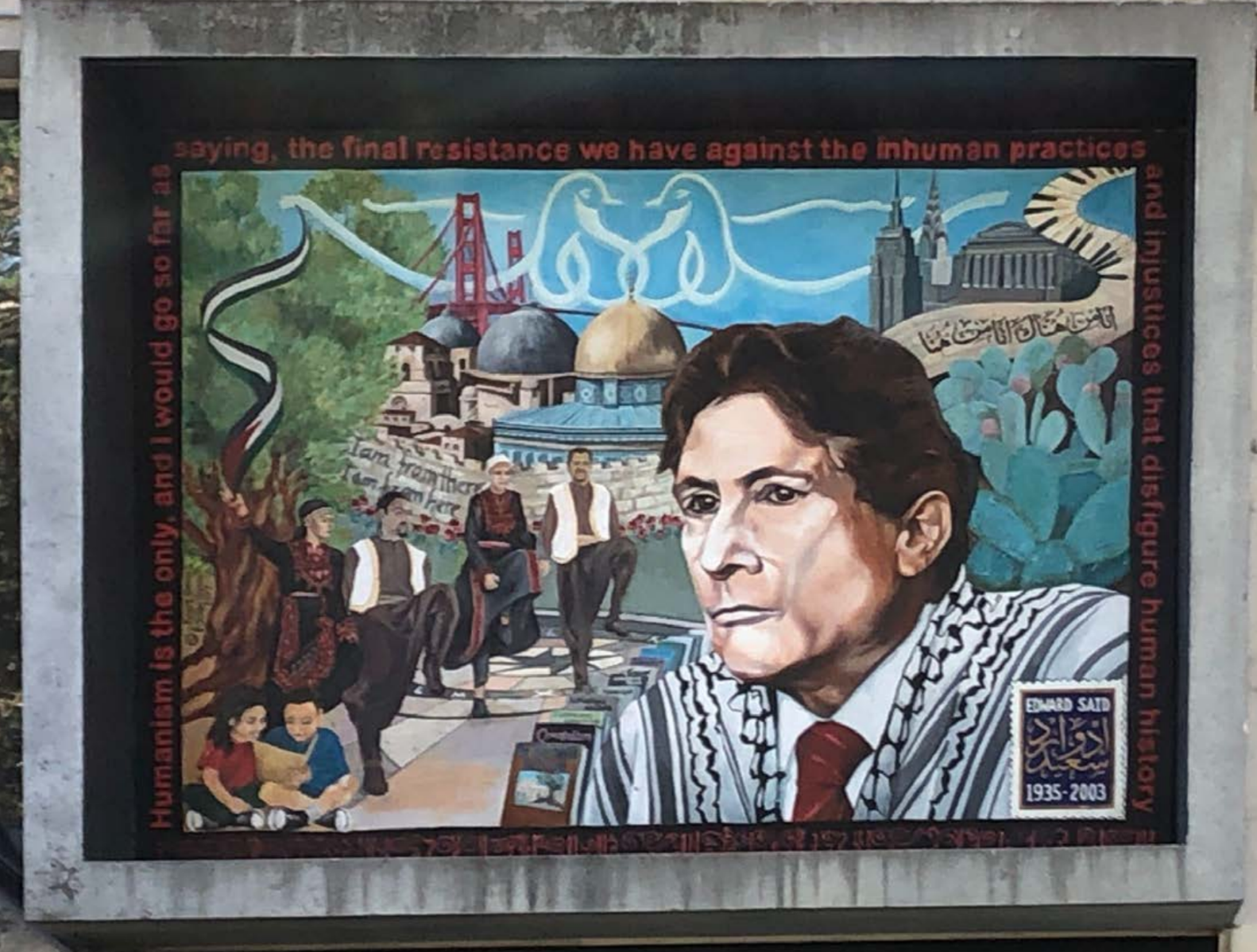
Edward Said Mural
Fayeq Oweis and Susan Greene
2007 Frogs Often Sing Gloriously
Exterior of Cesar Chavez Student Center
SF State Ethnic Studies Murals
Significance:
Represents Palestinian culture and honors professor Edward Said who was an activist against Orientalism.
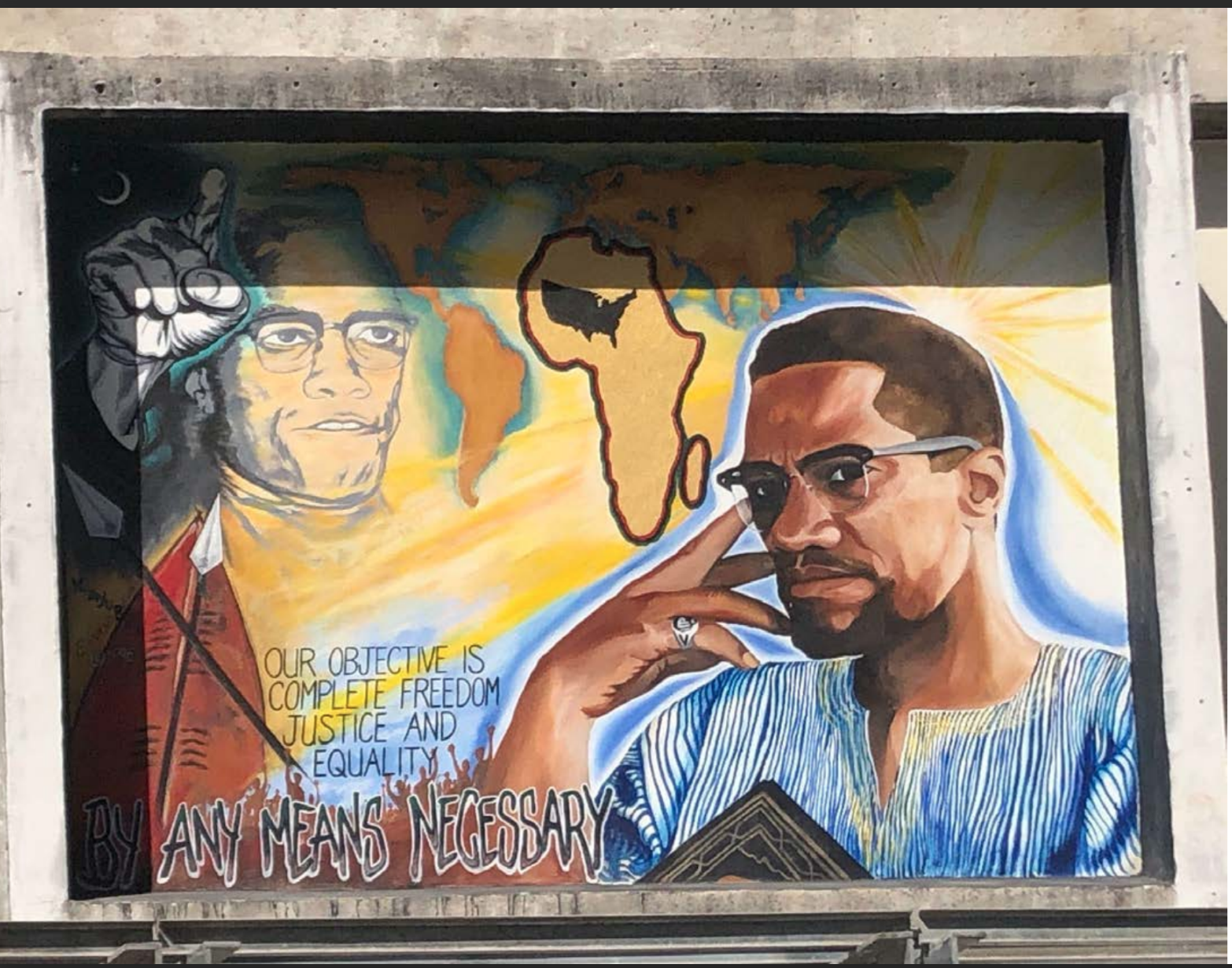
Malcolm X Mural: By Any Means Necessary
Eric Norberg and Kamau Ayubbi
1996 Elephants Never Kick Ass
Exterior of Cesar Chavez Student Center
SF State Ethnic Studies Murals
Significance:
Celebrates the legacy of Malcolm X, a prominent African American human rights activist during the civil rights movement, paying tribute to his contributions to the struggle for justice and equality.

As Much as things Change, They Stay the
Same
Emory Douglas
2013
Significance:
A response to police violence against African Americans, underscoring the persistent nature of societal issues and highlighting the need for continued activism in order to make a change.
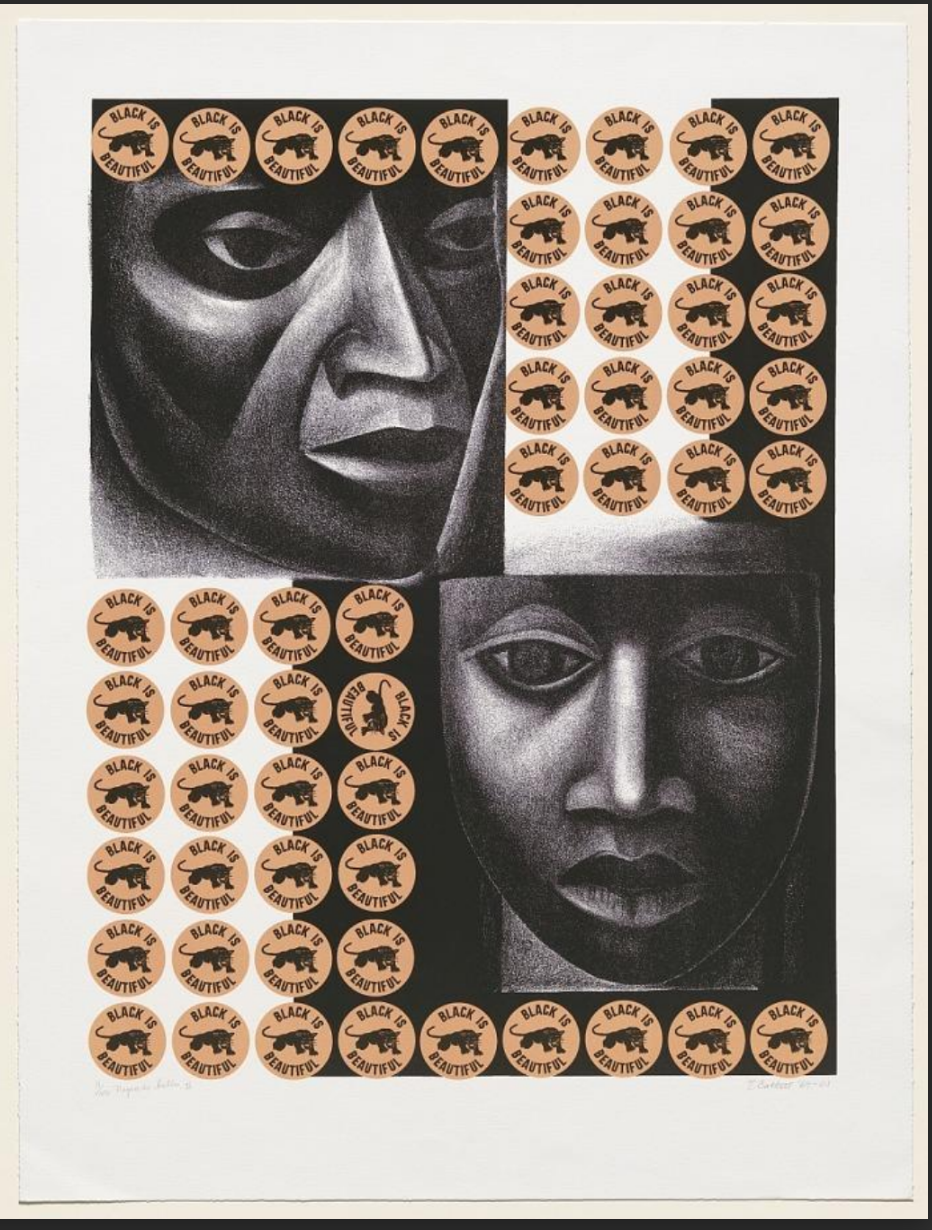
Negro Es Bello II
Elizabeth Catlett
1969, printed 2001
Ink rag on paper
Significance:
Celebrates Black beauty and pride, contributing to the Black Arts Movement, while challenging negative stereotypes and promoting a positive representation of African American identity during a critical period in the fight for civil rights.

Whose Utopia
Cao Fei
2006
Significance:
Offers a critical commentary on the impact of industrialization and globalization on identity and human experience, while reflecting on the complexities of contemporary Chinese society.
Additional notes:
Cao Fei's reimagining of the Chinese factory space represents the invisible aspects within Burtynsky's work (another required image), contributing to a nuanced exploration of the evolving roles and responsibilities of photographers/artists in documenting and representing Others.
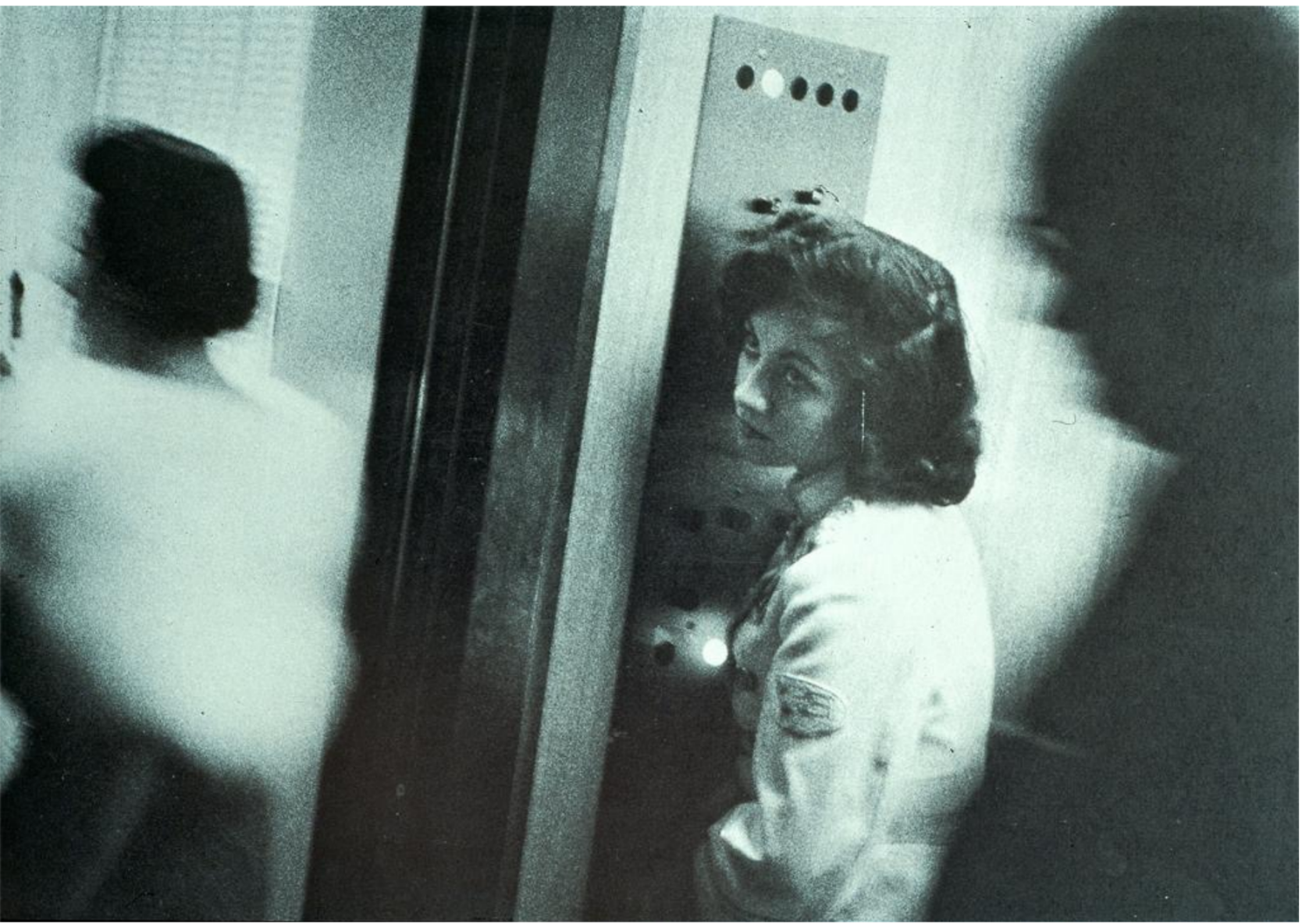
Elevator
Robert Frank
1956
From the photographic book The Americans
Gelatin silver print
Taken in Miami Beach
Significance:
Captures an unfiltered and candid glimpse into everyday life, embodying Frank's documentary approach that delves into the cultural nuances of American society.

The Americans
Robert Frank
1958
Photographic book
Significance:
A seminal work in ethnography, offering an unfiltered and critical portrayal of mid-20th-century American society and providing an intimate exploration of diverse communities, thereby transcending conventional documentary photography.
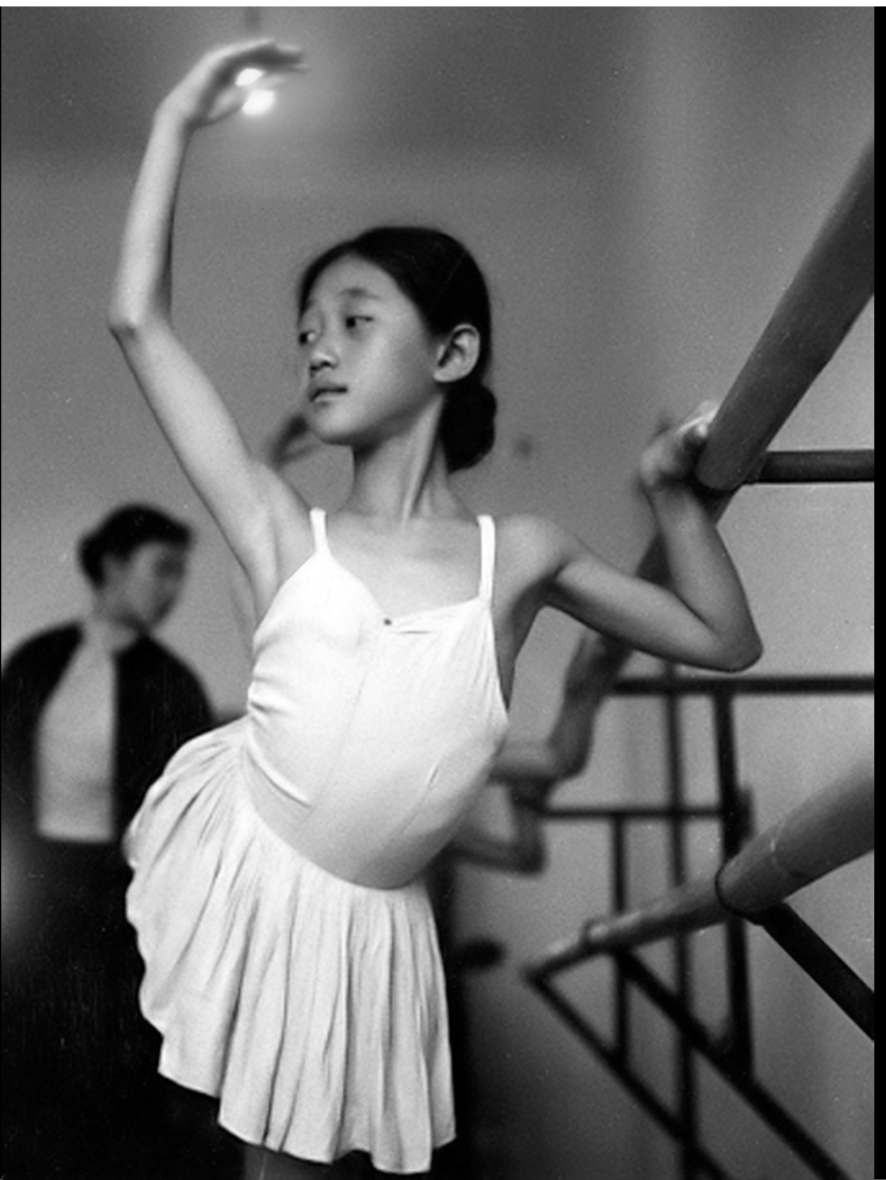
Korean Ballerina
Chris Marker
1957
From the photographic book Coréennes
(Koreans)
Gelatin silver print
Significance:
An example of ethnographic photography that invites viewers to reflect on notions of identity, representation, and the complexities inherent in portraying individuals from different cultural backgrounds within the broader context of post-colonial and global narratives.

Manufacturing #2)
Edward Burtynsky
2004
Yuyuan Shoe Factory, Gaobu Town, Guangdong
Province
Significance:
As a Canadian photographer depicting Chinese factories, Burtynsky's work raises questions about the ethical considerations and academic responsibilities of artists in capturing Others, setting the stage for the discussion on the evolving concept of documentary photography and the tensions between artistic freedom and ethical representation.